How many types of fruits have you eaten? A lot, right? Apparently, fruits are a familiar kind of many different foods. They have played a certain role in supplying vitamins and minerals to humans’ bodies.
Fruits are everywhere, in different forms, colors, and flavors, which can be used in various cuisines and many dessert styles. Plus, one of the key factors that impact fruit cultivation is climate, making them vary from country to country.
Some fruits will be easier to find in tropical countries, while some are common in cooler temperatures. This article also covers them into 5 main groups: Simple (Fleshy Fruits and Dry Fruits), Multiple, Aggregate, Tropical, and Exotic fruits with several edible examples in these groups.
And after reading this, you can be a fruit expert to impress others. Wait no further! It is time to open your mind to the fruit world.
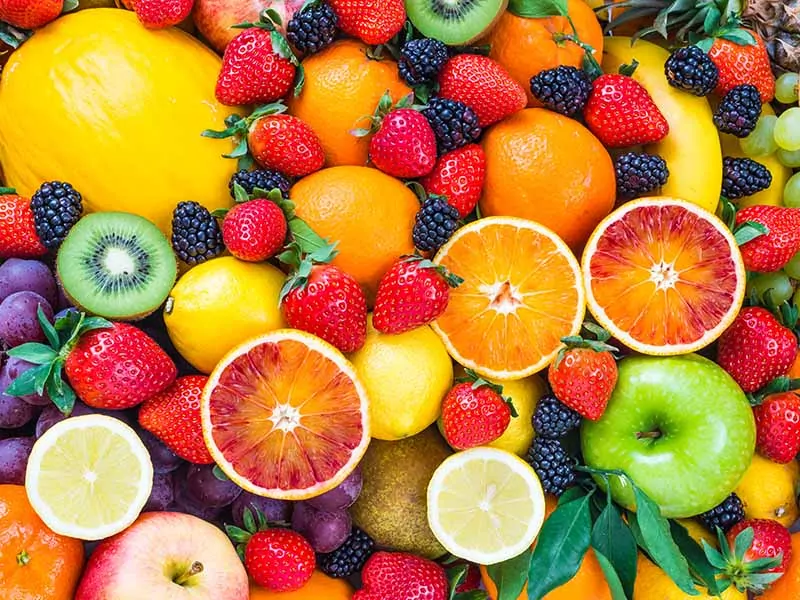
General Definitions Of Fruits
There are some differences in fruit definition between botanical and culinary views. In culinary, fruits refer to plants (or trees) that produce fruits with sweet or sour flesh and seeds which people can consume as a food sauce.
But in botanical language, fruits are all seed-bearing structures, including various types that people do not usually classify as “fruit”, for example, grain, nuts, and some “vegetable fruit”, like tomatoes, squash, eggplants, etc.
Lucky for you, this post will cover fruits in both culinary and botanical views so you can have the most comprehensive look at them.
What is Simple Fruit? and Which Fruits Belong To This Group?
As the name suggests, simple fruits are formed from a simple or compound ovary of a single flower (or 1 pistil). And they can be true fruit and false fruit (aka accessory fruit).
True fruit is a result of a ripened ovary of the flower. Examples of true fruit are mango, blueberry, cherry, etc. In contrast, false fruits refer to those that derive from other parts (like adjacent tissue) rather than the ovary, like strawberries, apples, and cucumbers.
But in this section, I will divide them into 2 big categories: Fleshy and Dry fruits for easy understanding. Let’s scroll down to learn more!
Fleshy Fruits
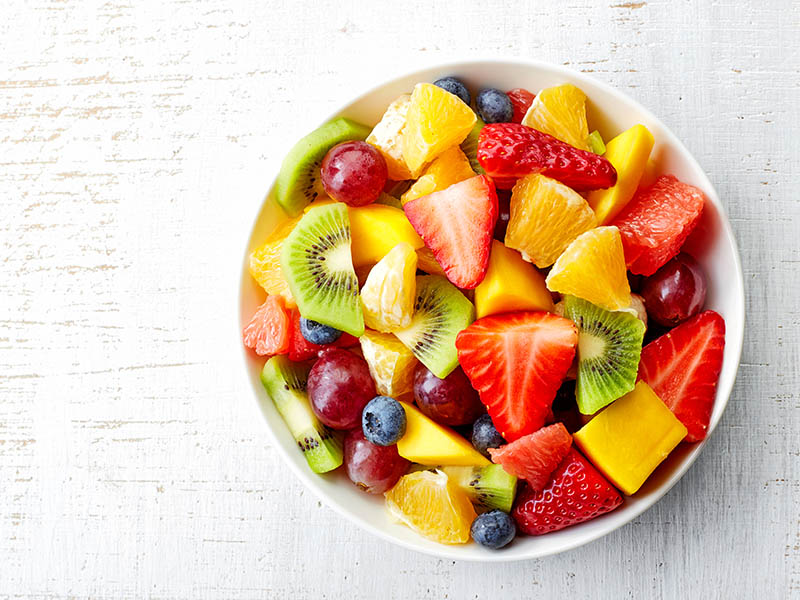
The fleshy fruit is a general term to refer to those with 3 layers: exocarp (outermost skin), mesocarp (the middle part with plentiful flesh), and endocarp (containing seeds).
These fruits will not split open, and can be grouped into 5 separate classifications: Berry, Citrus, Pepo, Pome, and Drupe or Stone fruits. And all of them will produce a fleshy inner when they mature, so you might need a fork kindto spear and hold the fruit while eating.
Berry Fruits
When mentioning fleshy fruit, the berry is the most recognized type. They contain seeds in the middle of the fruits covered by succulent flesh. However, the term “berry” might be confusing since strawberries and blackberries, which have “berries” in their names, are not true botanical berries.
They belong to other groups, which I will explain later. Instead, grapes, blueberry, and avocado are simple berry fruits. Interesting, isn’t it? Moreover, the berry is developed from an individual ovary or flower.
Overall, berry fruits feature a small-sized fruit with sweet, sour, or tart flavor. Their colors and shapes vary too! And they are healthy choices for people with diabetes.
Check here to know why strawberries are not berries, but bananas are.
1. Grape
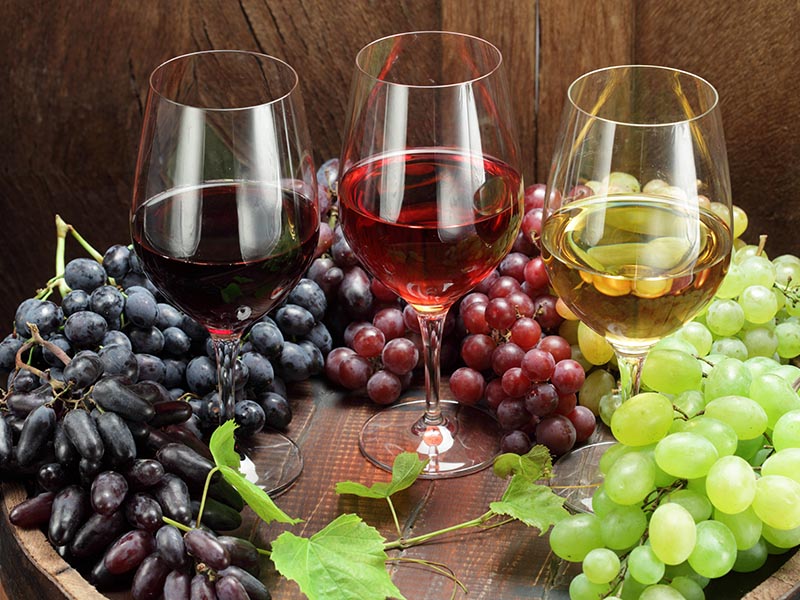
Botanically, the grape is 100% berry fruit belonging to the Vitis genus. There are many grape varieties worldwide for 2 main purposes, including table grapes (famous for sweet flavor) and winemaking grapes (tart taste).
It is a versatile fruit as you can use them to make juice, jelly, oil, and dried products (raisins). Moreover, they are non-climacteric fruit, which simply means grapes will not continue to ripen after picking.
Grape’s skin colors are usually green, red, dark purple, or black based on their varieties. They have been a significant fruit in the Middle East, where people cultivated them from 6,000 to 8,000 years ago. Back then, they used grapes to produce alcoholic drinks.
Grapes can be seedless or seeded. In reality, grapeseed oil is also a beneficial option since it contains a high level of vitamin E (tocopherols), polyunsaturated fatty acids, and phytosterols, making them an ideal fruit for skincare items.
Grapes leaves are impressive as they can be a great ingredient to make some tasty dishes, such as Dolma, in Middle Eastern or Mediterranean cuisine.
Nutrients (per 100 g):
- Energy: 288 kJ
- Sugar: 15.48 g
- Vitamin C: 3.2 mg
- Vitamin E: 0.19 mg
- Potassium: 191 mg
- Calcium: 10 mg
- Phosphorus: 20 mg
Wanna know more about grapes? This lively introduction will show you.
2. Blueberry
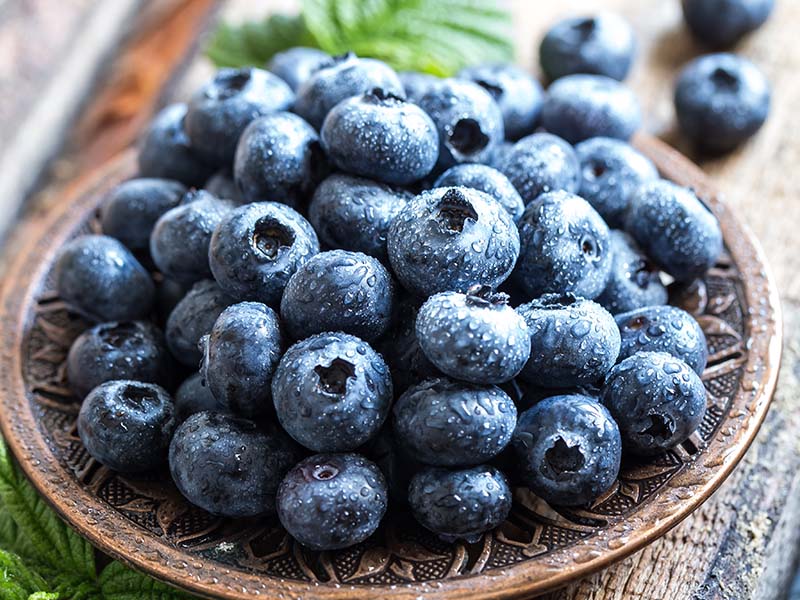
As their name suggests, blueberries have dark blue or purple color when mature. Humans classify them into 2 groups: lowbush (wild) and highbush (cultivated) ones.
But regardless of their types, blueberries originate from North America. And the highbush cultivated blueberries started to spread their popularity in Europe in the 1930s. Moreover, this blue-colored fruit is in the same genus Vaccinium as cranberry, huckleberry, and bilberry.
In general, lowbush fruits might be smaller than highbush ones, and their growing locations are varied. The USA occupies 40% of highbush blueberries in the world, while a significant number of this fruit in Canada is lowbush. They are also popular in Australia and New Zealand.
Their taste is delicately sweet with mild acidity, making them enjoyable to eat fresh. Add them to your breakfast with cereal. Besides, blueberries are available in frozen packages for other purposes like making juice, jelly, jams, or various desserts.
Nutrients (per 100g):
- Energy: 240kJ
- Carbohydrate: 14.49 g
- Protein: 0.74 g
- Vitamin C: 9.7 mg
- Vitamin K: 19.3 μg
- Dietary fiber: 2.4 g
- Calcium: 6 mg
- Potassium: 77 mg
Blueberries are awesome, but how do they grow?
3. Avocado
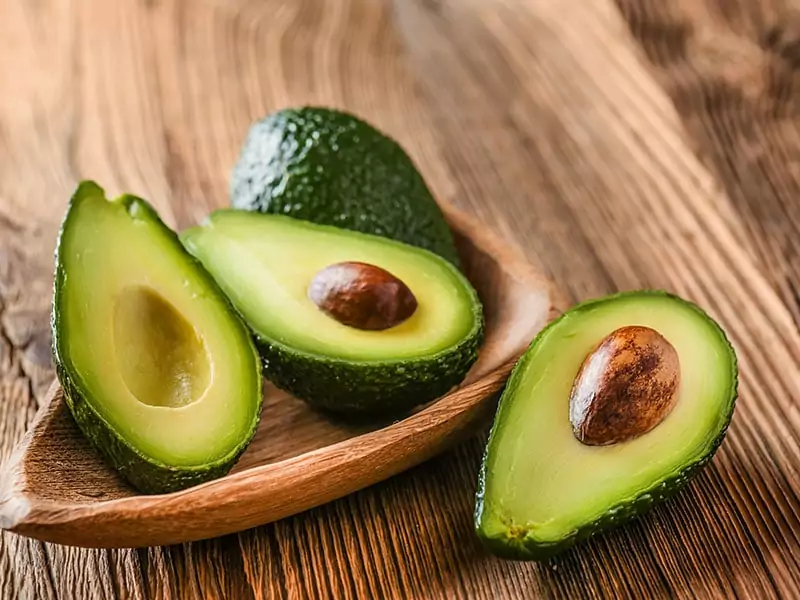
The exact origin of avocados is still unclear, but many people claim they are native to the South-central of Mexico. Therefore, they appear in many exotic Mexican foods. Nowadays, people can cultivate them well globally, and of course, Mexico is still the top producer.
There are various kinds of avocados that normally come in a medium pear-shaped with brown, green, or black skin when mature. Cut them in half; you will see the firm, light-green flesh with a big seed in the center.
If you see their flesh turning black (or brown) and soft, your avocado might be overripe as they can continue to ripen after harvesting.
They have a subtle earthy, nutty, and buttery flavor with a creamy texture. Avocados fit well in both sweet and savory recipes. If you are vegan, this fruit can be a good choice thanks to its high-fat level, and it can make you feel full for longer.
Some people (including me) refer to eating them raw. But if you want to add some twists to your avocado-based dishes, mash them and add some spices to turn them into famous guacamole in Mexican cuisine.
Nutrients (per 100g):
- Energy: 670kJ
- Fat: 14.66 g
- Protein: 2 g
- Vitamin C: 10 mg
- Vitamin E: 2.07 mg
- Vitamin K: 21 μg
- Calcium: 12 mg
- Phosphorus: 52 mg
- Potassium: 485 mg
Other berry fruits: Banana, gooseberry, tomato, chili pepper, cranberry, and more.
Taste great, packed with many health benefits; what else could you expect in avocado, right?
Citrus Fruits (Hesperidium)
In fact, hesperidium is a minor part of a group of berry fruits. But it would be easier to learn a new thing if I mentioned them in a separate part. The key characteristic of these fruits is their leathery rind with the juicy inner part.
And the majority of hesperidium fruit is various species of citrus fruits, like lemon, orange, and grapefruits. And as they belong to the berry group, citrus fruits are highly-recommended choices for diabetes. So keep reading for more insights.
4. Lemon
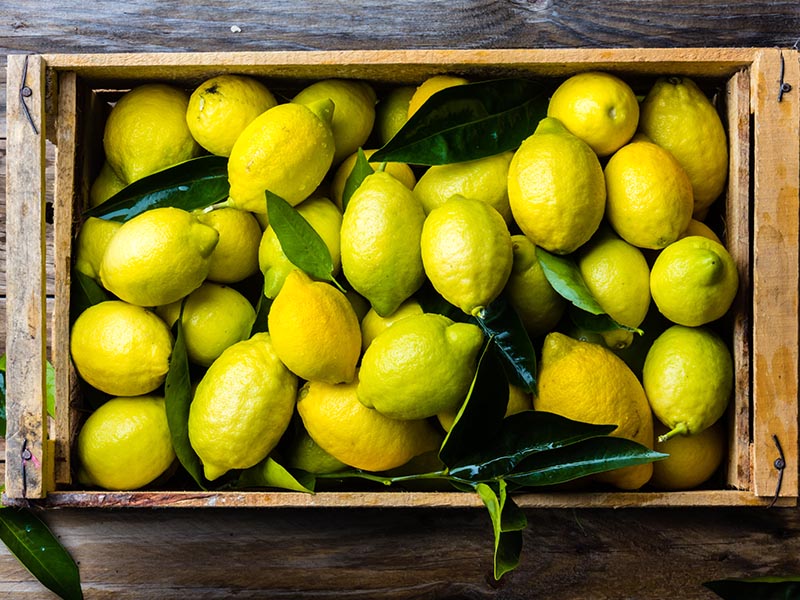
The first lemon cultivation in Europe started in the 15th century and spread around the world with many different lemon cultivars. In reality, lemon is native to Asia countries, like China and Myanmar, then traveled to Europe in the ancient Rome era during the 2nd century AD.
The most popular one sold in the supermarket is Eureka lemon, available all year round. This is also the type that people usually use to describe the color and texture of lemon in general, such as thick, bright-yellow skin and tart, mildly sweet with acidic hints.
Therefore, they are not ideal for eating raw. But if you do not like their sour taste, cut a small piece and try it. Lemon can go well with many dishes, from sweets to savories. Using it to make many kinds of beverages like juices or cocktails is common since its freshness can excellently light up your day.
Next to cooking uses, the acidic content in lemons makes them a valuable ingredient for cleaning purposes. Mix them with baking soda, water, or vinegar to increase the cleanup efficiency.
Nutrients (per 100 g):
- Energy: 121 kJ
- Vitamin B3: 0.1 mg
- Choline: 5.1 mg
- Vitamin: 53 mg
- Phosphorus: 16 mg
- Potassium: 138 mg
- Calcium: 26 mg
The advantages that you can receive from consuming lemon are huge. Check here to find out!
5. Grapefruit
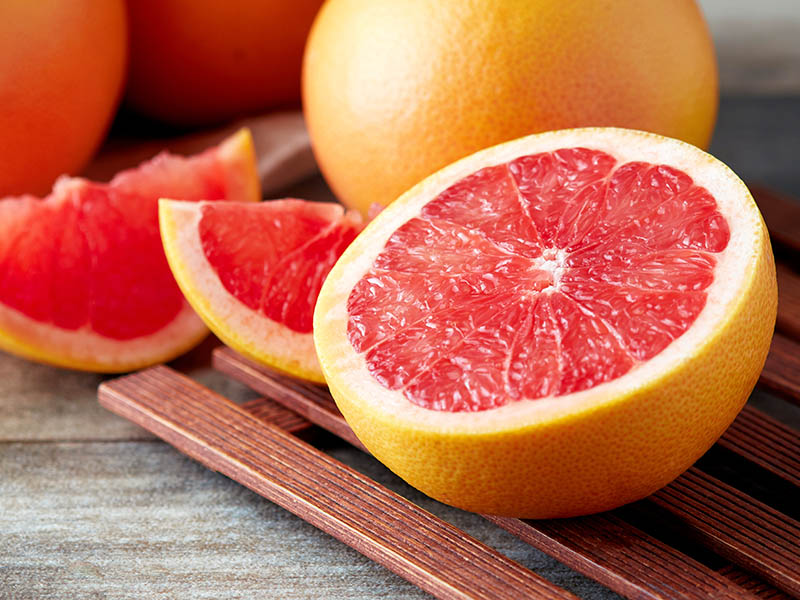
Grapefruit was accidentally discovered from the hybrid of sweet orange and pomelo in Asia in the 17 century. Their reputation in Asia is huge, especially in the list of Vietnamese fruits. And Vietnam is also the second-highest country that produces grapefruits in the world after China.
Different grapefruit kinds have different flesh colors, but the common colors are pink or yellow. Generally, it is a large citrus fruit with lightly sweet, bitter, and sour tastes. Their peel shades vary from orange to yellow with a thick texture.
Grapefruit is ideal for eating fresh or making juice. But people have found some interaction between drugs and these fruits as it can break down the drug’s activity. Therefore, you should check for the information for incompatible medicines with grapefruit on their package for safe consumption.
Nutrients (per 100 g):
- Energy: 138 kJ
- Vitamin B5: 0.283 mg
- Vitamin C: 33.3
- Calcium: 12 mg
- Potassium: 148 mg
- Magnesium: 9 mg
6. Orange
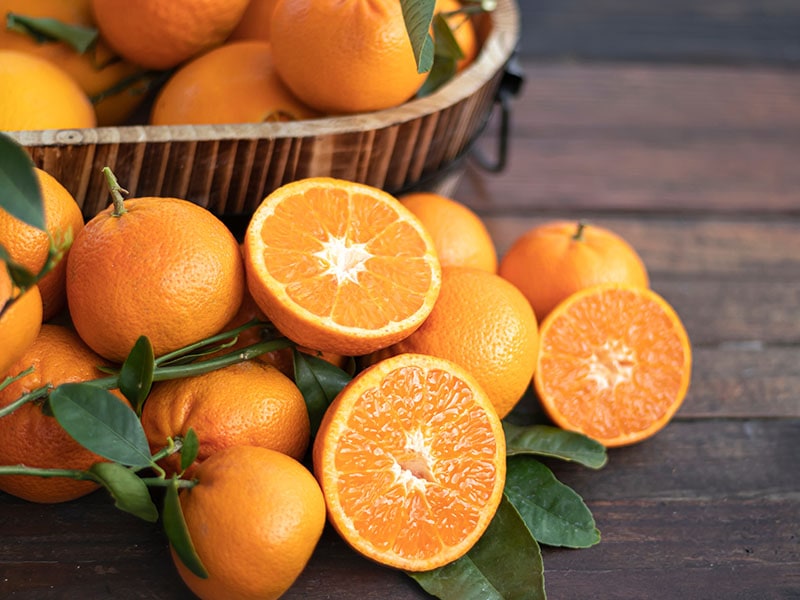
Orange is a cross between mandarin and pomelo, which are also citrus fruits. They have tough, thick skin to protect the succulent interior with a sweet-and-tangy taste. Their regular shape is round with medium-large size.
Either sweet or sour, you can consume oranges on their own, or squeeze them to make juice. Their rind can be used to make candy, food flavorings, or garnishing uses. Surprisingly, these thick peels contain a certain level of vitamin C, fiber, and minerals as much as their flesh.
There are many orange cultivars in the world with various characteristics. Still, regardless of their kind, oranges are a wonderful component in salad, syrup, marmalade, or other sweet and savory recipes.
Nutrients (per 100 g):
- Energy: 197 kJ
- Vitamin C: 53.2 mg
- Vitamin E: 0.18 mg
- Choline: 8.4 mg
- Magnesium: 10 mg
- Calcium: 40 mg
- Potassium: 181 mg
Other citrus fruits: Pomelo, yuzu, mandarin, citron, kumquat, and more
This short presentation will tell you why you should consume more oranges.
Pepo Fruits
Pepo is also another berry-type fruit. Overall, they also have fleshy inners, but what makes them different from another type (hesperidium/citrus fruit) is their hard rind.
7. Watermelon
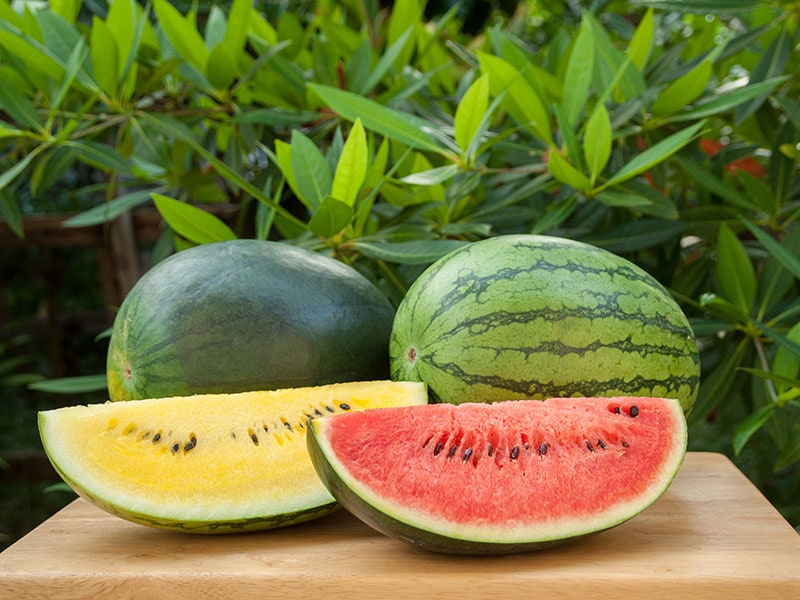
Watermelon is the most popular type of melon fruit. If you are looking for fruit to beat the heat in the hot summer, watermelon is the best.
In the past, humans cultivated them as a kind of food source to support water in the dry season. Indeed, there are 91.45 grams of water in a 100-gram watermelon.
The ideal conditions for them to thrive are tropical and temperate climates. And once again, China is the leading supplier of this fruit. Grab a bite of watermelon; you will feel the sweetness along with its incredible juiciness.
Therefore, the best way to enjoy them is on their own. But it would make your salad dishes or juice recipes taste more refreshing. Furthermore, their seeds are edible, so people can roast, dry, or ground them into flour.
Do not throw away their rind quickly because you can eat it too! However, these rinds should be pickled or paired with other veggies since the fresh ones taste quite bland and somehow unappealing.
Nutrients (per 100 g):
- Energy: 127 kJ
- Sugar: 6.2 g
- Vitamin A: 28 μg
- Vitamin B5: 0.221 mg
- Vitamin C: 8.1 mg
- Choline: 4.1 mg
- Potassium: 112 mg
- Water: 91.46 g
If you ever wish to have a small watermelon garden at home, you should not miss this instruction.
8. Squash
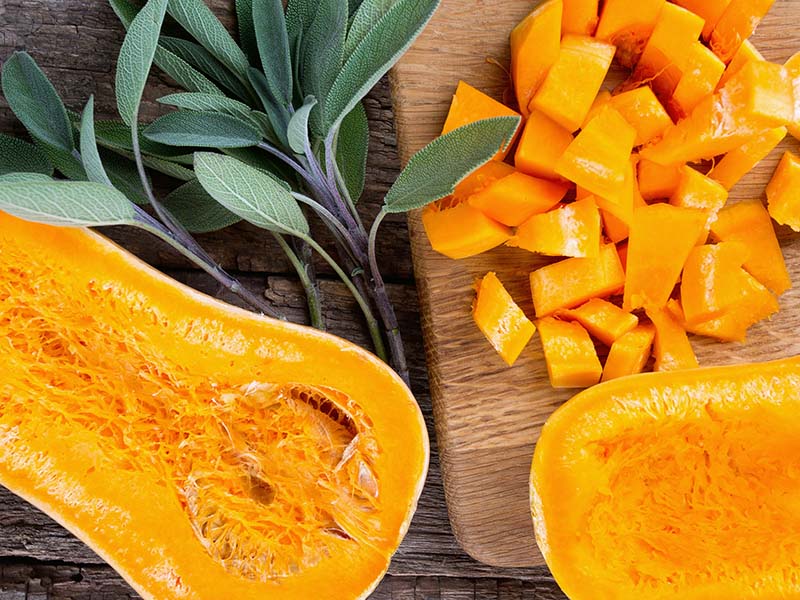
Squash is a fruit that people consume as a vegetable. There is a wide array of squash cultivars with various sizes and colors, which can be elongated, round, or pear-shaped in green, yellow, orange, brown, or white color.
This fruit’s origin is in the Americas, but its culinary uses worldwide are massive. You can easily buy them in your local market. In reality, they are one of many staples in the Americas, especially on Thanksgiving.
Bread, soups, stews, cakes, stuffing, lasagna, dessert, etc., there is no limitation in how you can turn a simple squash into tons of delicacies. Another greatest thing about them is their long shelf life, especially winter squash as they have thick skin.
Squash seeds are a good source to make snacks (roasted seeds), oil, or flour. The top squash producer is China, but America is also one of the top 5 countries that produce squash, particularly in North Carolina, New York, California, and Florida.
Nutrients (per 100 g):
- Energy: 69 kJ
- Vitamin B3: 0.487 mg
- Vitamin C: 17 mg
- Vitamin K: 3 μg
- Potassium: 262 mg
- Phosphorus: 38 mg
After checking this demonstration, cooking with squash cannot get easier.
9. Cucumber
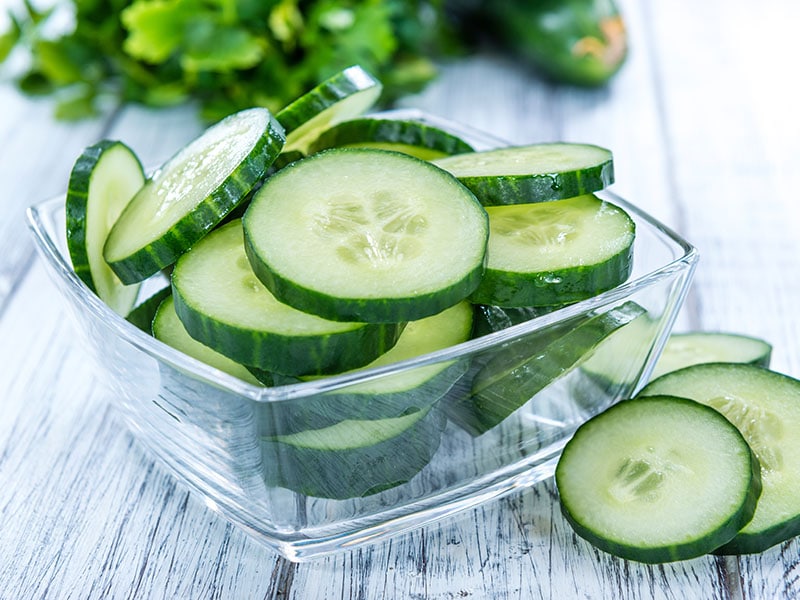
Originating from South Asia, they have appeared on various countries’ dining tables in different cucumber varieties. As a whole, cucumber is a cylindrical fruit that you can find in many salad dishes and cocktails.
There are 3 key cucumber cultivars: seedless, slicing, and pickling. Raw cucumbers have a subtle sweetness and mild melon aroma. However, some cucumbers are bitter, like the American slicing variety.
What makes raw cucumbers so well-liked is their crispiness. Plus, as they contain 95% water, consuming cucumbers is a good way to relieve dehydration, making them another suitable choice to serve on your dining table in hot weather.
Let’s talk a bit about its botany. Cucumber is actually a vine crop, and it might require a large space to thrive. So if you want to grow them in your yard, ensure they are big enough, as their vines can reach 6 to 8 feet or more in length.
Nutrients (per 100 g):
- Energy: 65 kJ
- Water: 95.23 g
- Vitamin C: 2.8 mg
- Potassium: 147 mg
- Calcium: 16 mg
- Phosphorus: 24 mg
Other pepo fruits: Pumpkin, cantaloupe, etc.
Pome Fruits
The next common type is pome fruits. So what is pome? They are a group of simple accessory fruit grown from 1 or a group of carpels surrounded by tissue (like receptacle or hypanthium).
Quite complicated to understand? You can just remember, pome fruits include apple, loquat, and pear. In fact, the term “pome” came from the old French word to refer to apples or apple-shaped items.
10. Apple
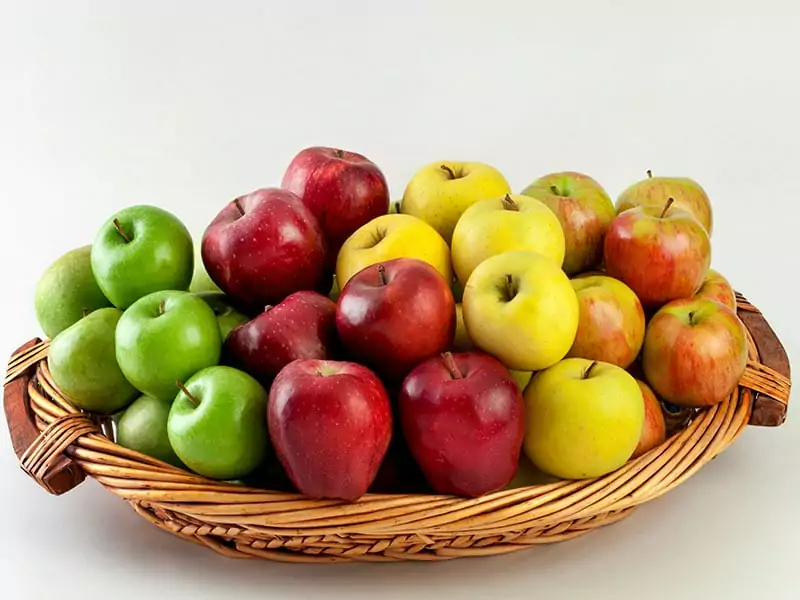
Apple is an incredible source to improve your health as they are rich in antioxidants and fiber to lower various risks relating to heart disease, cancer, and diabetes. If you need fruit to support your weight-loss plan, apples are a good friend.
Apple is one of the most widely grown fruit in the world with several apple kinds, but its true root is Central Asia from thousand years ago. Besides being a healthy fruit, the apple is a religious symbol in some cultures, like Greek, Norse, and European Christian.
Apple’s shape is generally round or spherical and quite tapper at the bottom end. The standard size for commercial purposes is from 2 3/4 to 3 1/4 inches in diameter. But the market’s requirements might differ by country; for example, the Japanese prefer bigger ones.
Their color varies based on cultivars (with more than 7,500 varieties). The standard color is red, but you can spot some in green, yellow, or pink. Most apple skins are covered by a thin wax layer to avoid moisture loss.
Nutrients (per 100 g):
- Energy: 218 kJ
- Sugar: 10.39 g
- Vitamin C: 4.6 mg
- Vitamin E: 0.18 mg
- Calcium: 6 mg
- Potassium: 107 mg
- Phosphorus: 11 mg
The history of apples is worth discovering.
11. Pear
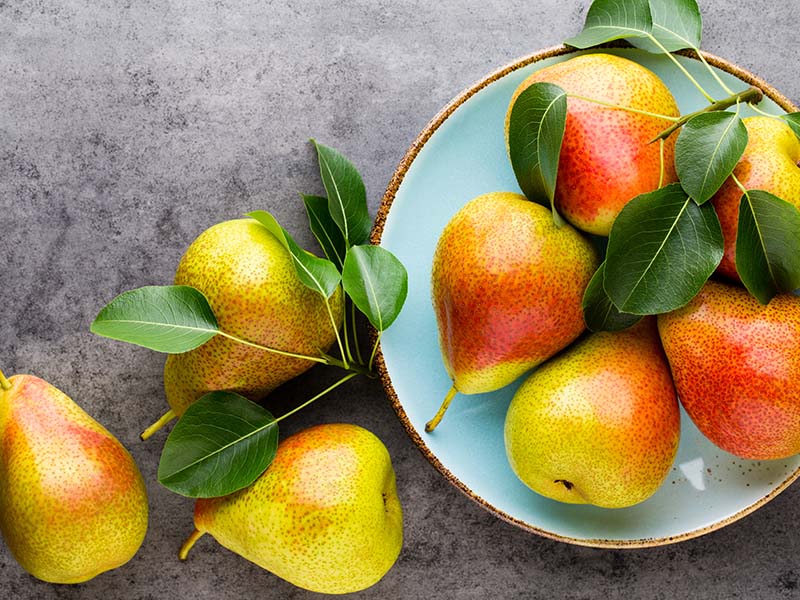
Pear is another common fruit in the pome fruits. They normally have curves with a tapered top and wider bottom. But some pears might share the same appearance as apples (e.g., nashi pear).
Their skin is smooth and thin in green, yellow, red, or white color, depending on their varieties. Under these delicate skin is crisp, sweet, and juicy flesh, so you can eat them fresh, and make juice, canned, or dried foods.
There are numerous pear cultivars (around 3,000 varieties), mostly cultivated for edible fruit; others are for their wood as pearwood is a high-quality type to manufacture furniture.
Besides, pear is a climacteric fruit, so it can continue to ripen given enough time at room temperature. When pears fully mature, store them in the fridge for longer shelf life. If you find your fruit covered by many dark spots with a very soft texture, do not consume it as this pear is overripe.
Nutrients (per 100 g):
- Energy: 239 kJ
- Sugar: 9.75 g
- Vitamin E: 0.12 mg
- Vitamin C: 4.3 mg
- Choline: 6.1 mg
- Potassium: 116 mg
12. Quince
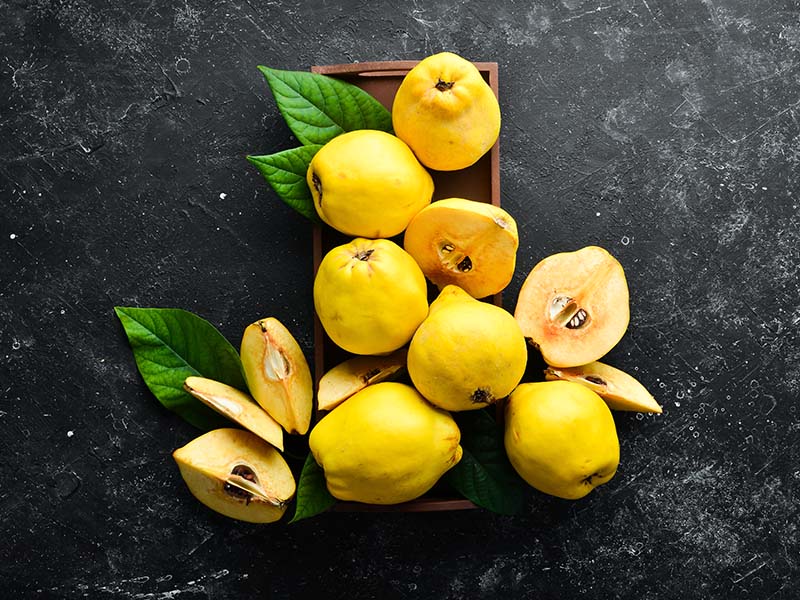
Most quince varieties can be too sour and hard to eat raw (except Kuganskaya and Aromatnaya quince). Therefore, the best way to use it is to cook, roast, or use quince to make jellies, jams, pudding, or marmalade as they are high in pectin content.
Overall, they have a strong aroma and flavor, so if you want to increase the taste of your apple pies, add a small quantity of quince. Moreover, some countries in Europe use them to make alcoholic drinks.
If you have not seen a quince before, just imagine them as a big-sized plum with thin bright yellow skin. They have a core in the center and creamy white flesh like apples and pears. They will turn red if you cook them with sugar for a long period.
Nutrients (per 100 g):
- Energy: 238 kJ
- Carbohydrates: 15.3 g
- Vitamin C: 15 mg
- Vitamin B2: 0.03 mg
- Vitamin B6: 0.04 mg
- Potassium: 197 mg
Other berry fruits: Medlar, rowan, etc.
How to eat a quince correctly? Check here and find out!
Drupe/Stone Fruits
The main traits to recognize drupe fruits are their 1 hard stone/pit in the center surrounded by the fleshy part (mesocarp) and the thin skin outside (exocarp). Plus, the stone is developed from the ovary of a flower.
Regarding their stone, drupe can be set in 2 stone kinds such as clingstone (a stone clinging to the flesh) and freestone (no clinging to the flesh). Their flavor profile is normally sweet with many nutrients.
13. Peach
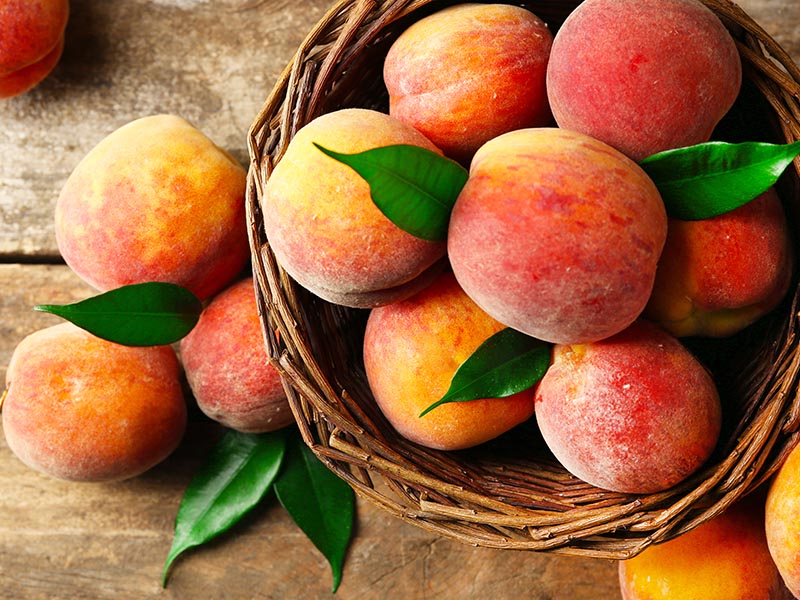
Peach – a wonderful fruit with floral sweetness, slight acidity, and light fragrance, is a great source of vitamin C and A. Moreover, nectarines and peaches belong to the same species, but peach skin is fuzzy while nectarines skin is not.
They are also in the same family with apricot, plum, almond, and cherry. People classìy peaches into 2 groups based on the stickiness of their stone. Clingstone peaches are those flesh sticks to stone, and conversely, the freestones type does not.
Their flesh color varies based on different peaches types. For example, white-fleshed fruits are low in acid and more popular in Asia, like Japan and China. But Americans are more favored by the yellow-fleshed peach with a higher acidic taste. But both are delicious fruits for cocktails.
Fun fact: Georgia is known as a peach state in the USA since they produce many superior peaches.
Nutrients (per 100 g):
- Energy: 165 kJ
- Vitamin A: 16 μg
- Vitamin B3: 0.806 mg
- Vitamin E: 0.75 mg
- Vitamin C: 6.6 mg
- Potassium: 190 mg
- Phosphorus: 20 mg
14. Cherry
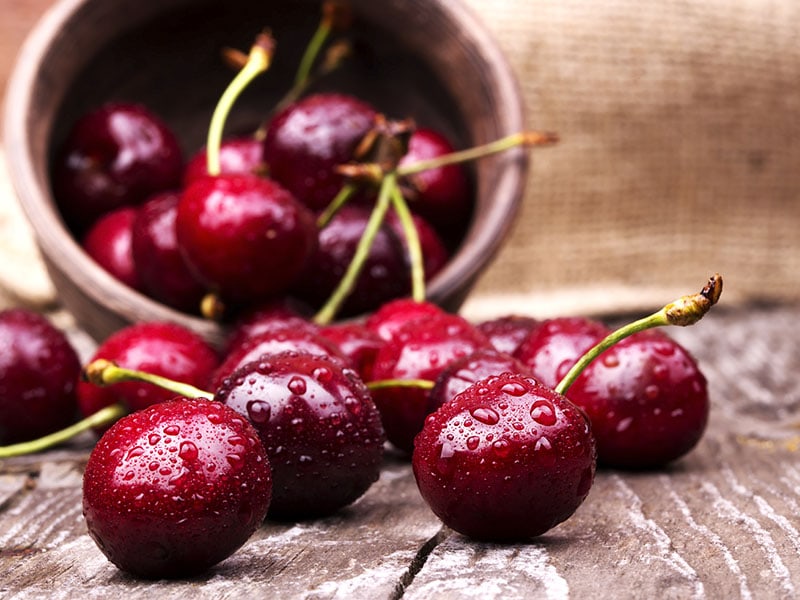
There are a lot of cherry cultivars in the world, but their 2 main types are sweet and sour cherries. If you want to eat them fresh, choose sweet types as sour fruits are mainly used for culinary purposes.
Sweet fruits are predominantly grown in Turkey and the United States, while sour ones are widely-grown in Russia. Furthermore, they can grow well in colder climates, making them incompatible fruit to cultivate in hot countries like Southeast Asia.
The common color of cherry is red to dark red, but some might have yellowish-red skin with white flesh. Interestingly, sour cherries are higher in nutrients, such as vitamins A and C.
Nutrients (sweet varieties / per 100 g):
- Energy: 263 kJ
- Carbohydrates: 16 g
- Vitamin B5: 0.199 mg
- Vitamin C: 7 mg
- Magnesium: 11 mg
- Calcium: 13 mg
- Potassium: 222 mg
- Sugar: 12.8 g
How many health benefits could cherries bring to our lives?
15. Mango
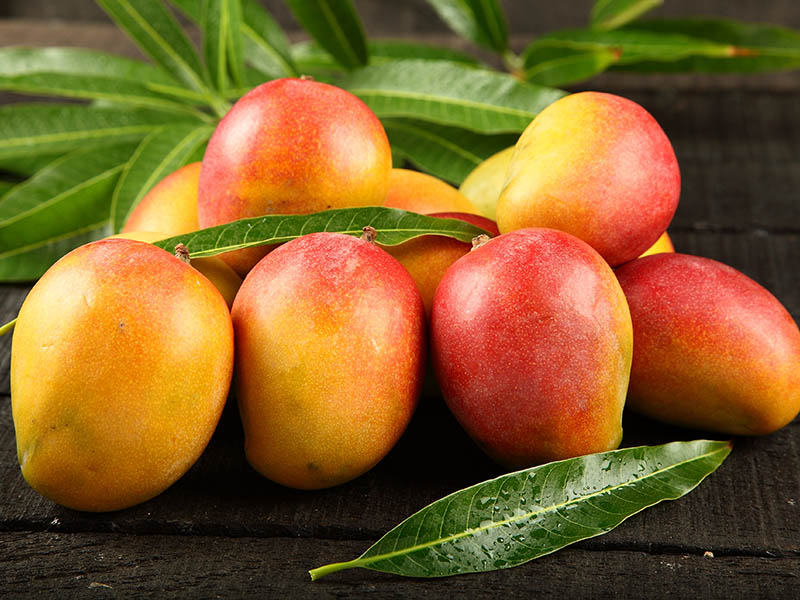
Mango contains a high level of sugar, making them ideal for enjoying raw so you can taste its full flavor. Besides their sweetness, mango carries some light tanginess with a soft texture when ripe.
They are a favorite fruit in India, where you can find thousands of cooking recipes with this tasty fruit. And India has the biggest mango production in the world. Overall, as they are native to South and Southeast Asia, mango is one of many favorite tropical fruits.
Additionally, mango cultivars are wide with various sizes, skin/flesh colors, shapes, and sweetness levels. Normally, they are oblong with a big and hairy pit in the center. Their skin color ranges from green to orange-yellow when fully ripe.
Unripe mangoes are ideal for making chutney spread or pickles. In reality, these green fruits are popular street food in the Philippines. So if you have a chance to visit this country, you can find many hawkers selling them on the sidewalk.
Nutrients (per 100 g):
- Energy: 250 kJ
- Sugar: 13.7 g
- Vitamin A: 54 μg
- Vitamin B9: 43 μg
- Vitamin C: 36.3 mg
- Potassium: 168 mg
- Calcium: 11 mg
Other drupe fruits: Olives, plums, pecans, loquat, etc.
Let’s learn how to cut mangoes today!
Dry Fruits: Dehiscent and Indehiscent
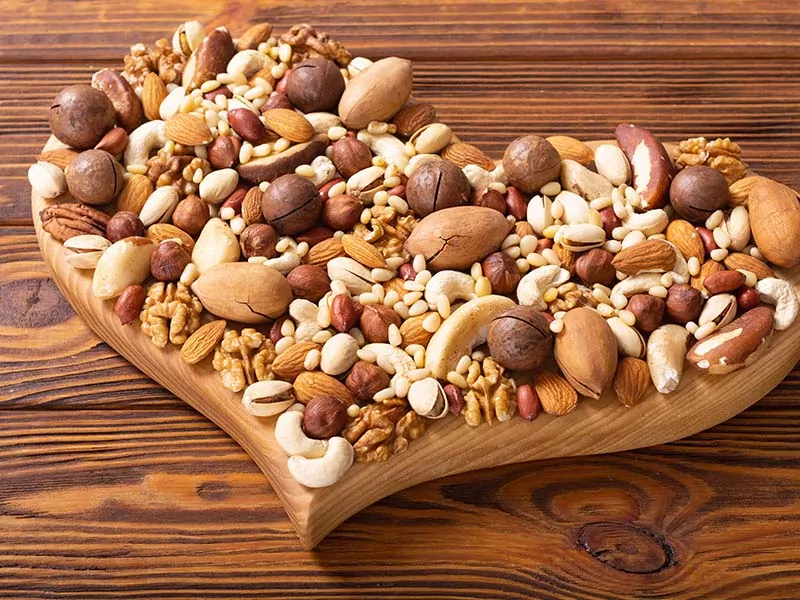
In the plant anatomy, dry fruits are simply those that can produce dry pericarp (a part formed from the wall of a mature ovary) when they reach their maturity. There are 2 main groups of dry fruit, namely Dehiscent and Indehiscent fruits.
Each group also has other subclasses with different traits and fruits. And I bet you will be surprised by these dry fruits since there are certain sorts you would never guess are fruits (botanically).
Dehiscent Fruits
Dry fruits in a dehiscent group can open along the seams when they mature to release the seed inside them. However, not all dry dehiscent fruits are edible. In this section, I mainly cover the 2 popular edible types (Legume and Follicle) with their examples.
Legumes can be seen as the most common one in this group. Their fruit derives from 1 carpel and can split along their dorsal and ventral seams when reaching maturity. Bean and peas are famous legumes in human diets. Interesting, peanuts are legumes too!
The last (but not least) part of dry dehiscent fruits are follicles, describing a fruit that grows from a carpel and is open by one suture at maturity. Based on these characteristics, Macadamia nuts are a true follicle.
16. Bean and Peas
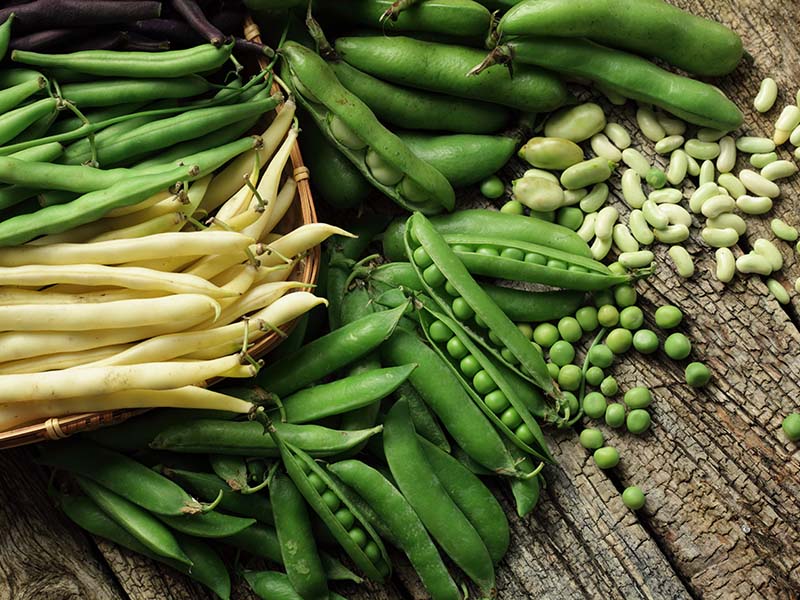
Bean and peas, botanically, are types of fruits that are mostly used for culinary purposes. That’s why many people do not know they are actually dry fruit since they consist of seeds and grow from an ovary.
As a whole, they play an essential role in human foods (even for livestock feed). They have been one of the key grain crops in human lives for a long time. And beans are a summer crop, while peas are winter crops.
Bean varieties are diverse, and so are the number of pea cultivars, which differ from region to region. Some are better for eating fresh; some come in dried, canned, or frozen forms.
There are many ways to turn them into delicious dishes as they can go well with other foods, like soup, stew, rice-based dishes, etc.
Their appearance is especially famous in European countries. Due to their rich nutrients, beans and peas are also staple foods in other countries, like America, India, China, Russia, and more.
Nutrients (per 100 g):
- Energy: 334 kJ (for beans) and 339 kJ (for peas)
- Carbohydrates: 10.5 g (beans) and 14.45 (peas)
Other nutrients in peas:
- Vitamin E: 0.13 mg
- Vitamin B3: 2.09 mg
- Vitamin C: 40 mg
- Calcium: 25 mg
- Potassium: 244 mg
- Phosphorus: 108 mg
It is not too hard to tell apart different types of beans.
17. Peanut
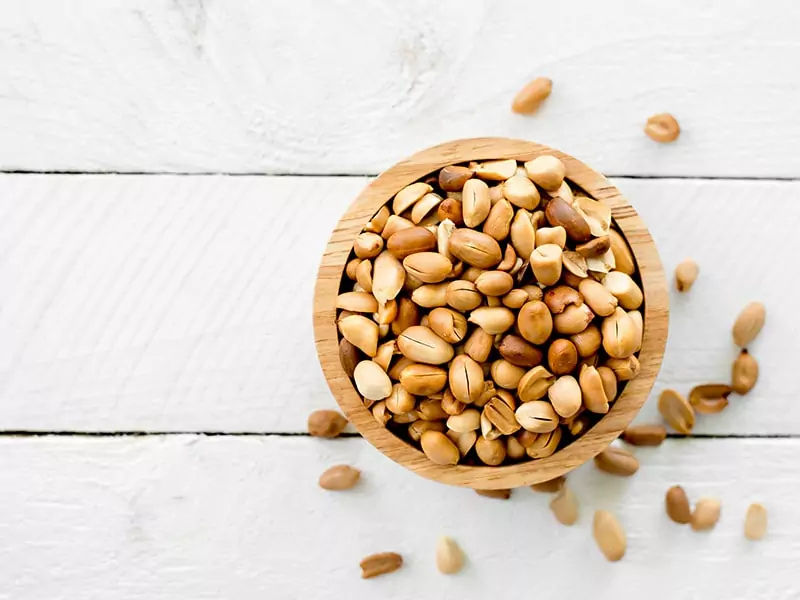
Peanuts are high in oil; that’s why they are widely used to create peanut oil. Unlike other legume fruits that grow above the ground, peanuts are underground fruit, so they have another name – groundnut.
The true origin of peanuts is unfound, but many think they were from South America, then spread to Europe by Spanish explorers. Today, the peanut is one of the most crucial crops in the USA.
Their cultivars vary globally, but the biggest peanut producer is China, with 17.5 million tons in 2019; the following are India, Nigeria, Sudan, and the United States.
People sell them in multiple forms. They can be dry-roasted, boiled peanuts to enjoy as a snack in China, India, Southeast Asian countries, etc., or make several types of peanut butter to spread on your pastry dishes. Moreover, peanut oil is also a healthier version than other saturated oils.
18. Macadamia Nuts
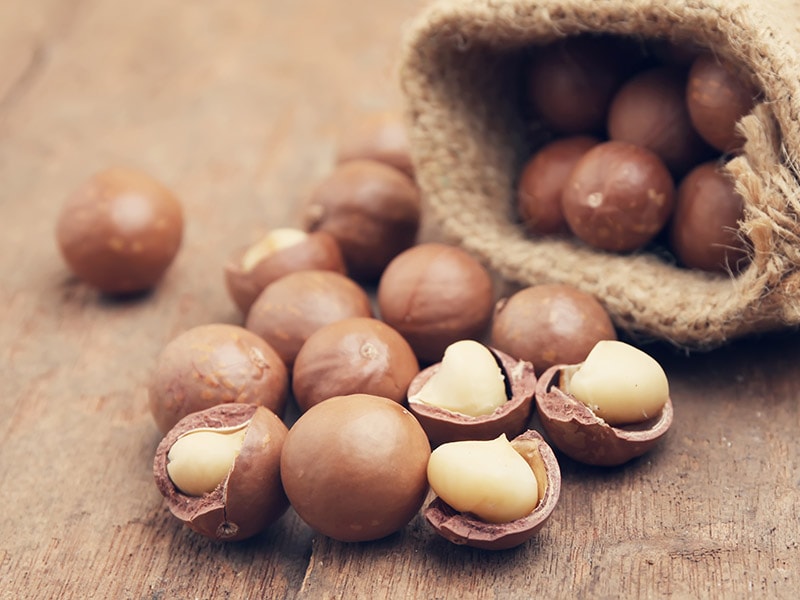
Macadamia is a native plant in Australia (particularly in New South Wales and Queensland). Nowadays, you can find them vastly in Hawaii, South Africa, and some Asian countries. And their other names are Hawaii nut, Queensland nut, or bush nut.
They have a tough nutshell that is 5 times harder than hazelnut shells. Under these shells are light-colored and round nuts with buttery, creamy, and nutty flavors. However, if you are a dog parent, do not let them consume this nut since they are toxic to your pet.
You can eat them raw or roast these nuts at low temperatures to turn them into healthy snacks. They are also a great deal to add vitamins, fiber, minerals, and other nutrients to your body.
Nutrients (per 100 g):
- Energy: 3,080 kJ
- Fat: 75.8 g
- Carbohydrates: 13.8 g
- Vitamin B3: 2.473 mg
- Vitamin C: 1.2 mg
- Calcium: 85 mg
- Magnesium: 130 mg
- Potassium: 368 mg
Macadamia nuts are one of the most expensive nuts, but why?
Indehiscent Fruits
In contrast, dry indehiscent fruits cannot open their splitting at maturity, and most of them consist of only 1 seed. Below are the 3 most popular subcategories of these fruits, including Grain (or Caryopses), Nut, and Achene.
Grains (in botany is caryopses) are small one-seed fruits covered by a pericarp. And the exterior layer of this pericarp is bran, and the inner is germ. They are not a seed because they come from a ripened ovary. Popular examples of this type are corn and rice.
Once again, not all the fruits with “nut” in their name belong to this group as there are differences between botanical and culinary nuts. In botany terms, nuts (Acorn and chestnuts) in dry indehiscent fruits have a single seed covered by a thick and hard shell.
Similar to nuts, achene indicates one-seeded fruits with small sizes. They normally grow in clusters that can fill the pericarp without adhering to it. And sunflower and quinoa are 2 perfect options to discover more about these healthy fruits.
A
19. Corn (or Maize)
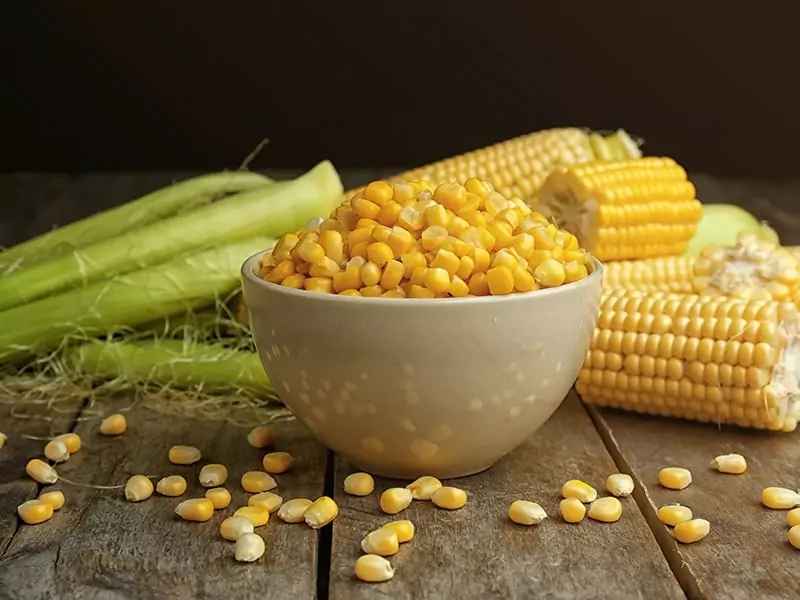
Corn (aka maize) is in the Gramineae family, including rice, wheat, barley, rye, sugarcane, and sorghum. The first appearance of corn was 10,000 years ago in Southern Mexico. And their importance in human food is vast.
There are 6 key corn types: sweet corn (mostly for human consumption), popcorn, flour corn, dent corn, pod corn, and flint corn. In culinary, people cook them as a vegetable. They are moderately sweet, buttery, and soft after cooking.
Corn is also a significant ingredient in making flour. Have you ever tried various cornbread kinds made from corn flour? I think you will love it. And among many cuisines, delicious Mexican foods are incomplete without corn.
The leading corn producer was the United States, with more than 300 million tons in 2018. So, in general, they are not only a staple food of humans but also for feeding animals.
Nutrients (raw / per 100 g):
- Energy: 360 kJ
- Carbohydrates: 18.7 g
- Protein: 3.27 g
- Vitamin B3: 1.77 mg
- Vitamin C: 6.8 mg
- Magnesium: 37 mg
- Phosphorus: 89 mg
Have you ever tried colorful corn like this one? If not, check out the documentary to learn more about this corn.
20. Rice
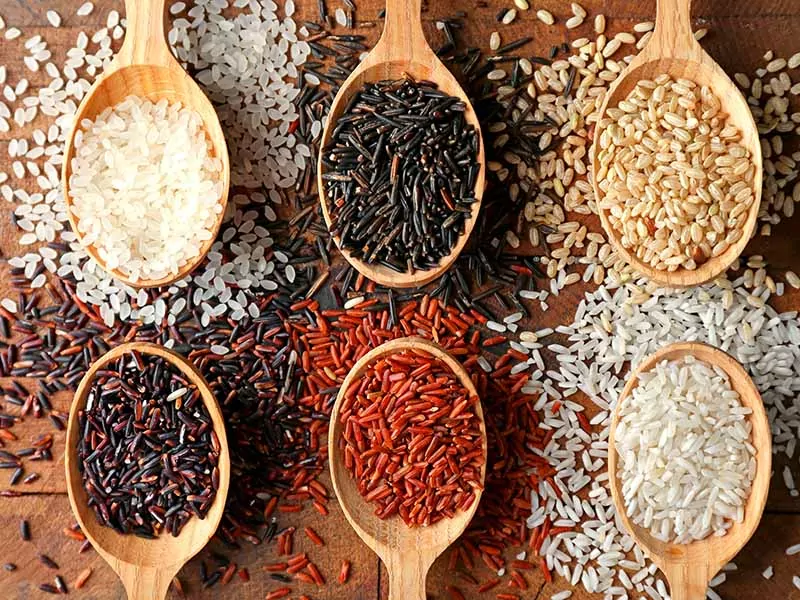
Rice is the most consumed food globally, particularly in many Asian and African countries. A rice grain typically has 5 to 12 mm in length and 2 to 3 mm in thickness.
Rice comes in many types, and the most common rice is the white type, but there are other colors like brown, black, and red, depending on their variety.
There are 3 main sizes of rice: short, long, or medium-grain rice. If you love Thai foods, they mostly use long rice to create their dishes. In contrast, the Japanese enjoy short rice, like those in making sushi. Medium-grain rice is more famous in European nations, like Spain and Italy.
The basic way to cook rice is to boil them. And people mainly consume them with other dishes. This is a good food source to provide energy, iron, and vitamins. But compared to white rice, you should opt for brown rice as they have higher nutrients than the white type.
Nutrients (cooked / per 100 g):
- Energy: 544 kJ
- Carbohydrates: 28.73 g
- Protein: 2.36 g
- Vitamin B3 and B5: 0.4 mg
- Magnesium: 8 mg
- Potassium: 26 mg
- Phosphorus: 33 mg
Other caryopsis fruits: Wheat, barley
Rice and its story will offer you a whole picture of why they are so amazing.
21. Acorn
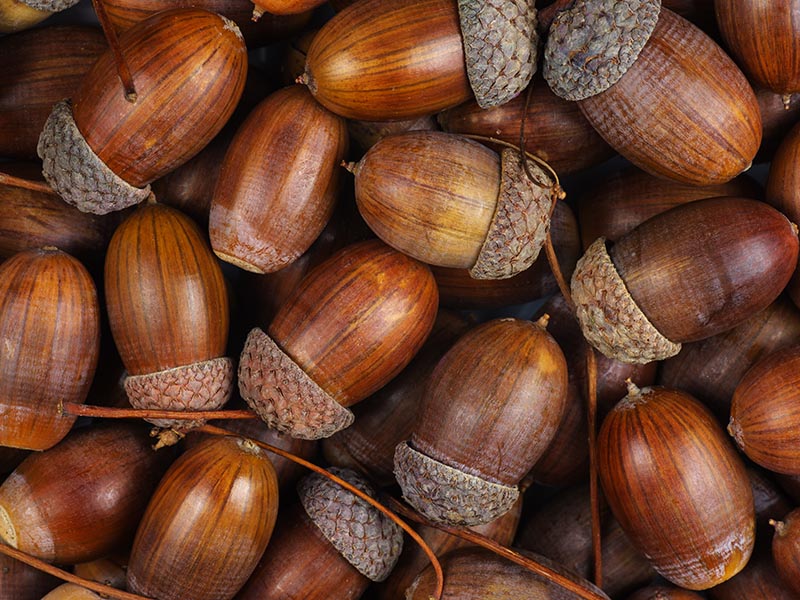
Acorn has a close association with human history as an important food source. Though more and more people choose other grain crops to consume, acorns are still a favorite ingredient in making various Korean foods, like noodles and jellies.
They are also a traditional food of indigenous people living in North America. So what is an acorn exactly? They are a fruit of oak trees, and there are many oak species with different acorns in terms of size, color, and texture.
They have a leathery shell with a cup-shaped appearance. Raw acorns might not be safe to consume, and they have a bitter taste as they contain a high level of tannins. However, if you prepare them correctly (like roasting), they have a sweet and nutty flavor.
Nutrients (uncooked / per 100 g):
- Energy: 1,619 kJ
- Fat: 23.85 g
- Protein: 6.15 g
- Carbohydrates: 40.75 g
- Vitamin B3: 1.837 mg
- Calcium: 41 mg
- Potassium: 539 mg
- Magnesium: 62 mg
- Phosphorus: 79 mg
22. Chestnuts
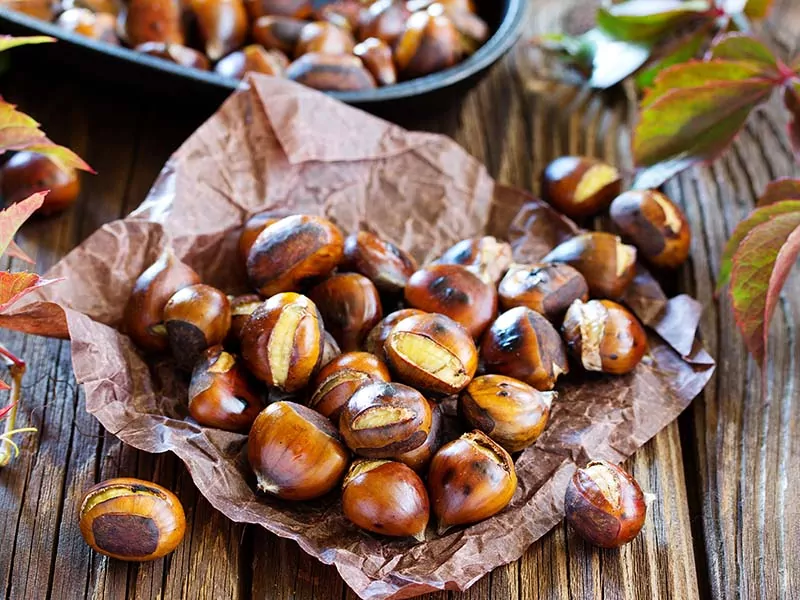
First, it is important to identify edible chestnuts since there are toxic chestnuts (e.g., horse chestnuts). As a whole, edible chestnut fruits have a glossy brown peel and are slightly pointy on the top, while non-edible ones do not have pointed tops.
They originated from the temperate part of the Northern Hemisphere. There are 4 main chestnut species: Japanese, Chinese, American, and European chestnuts. Chestnuts are an important part of the Japanese food menu in the New Year as they represent success and strength.
Generally, chestnuts can be eaten raw after you peel their shell off. But it would be much tastier if you roast them. After being cooked, you can sense their nutty and delicately sweet taste. Their texture is quite similar to cooked potatoes.
Other ways to prepare them are drying and grounding them into flour so you can use them for baking pies, bread, cakes, and making pasta. This flour is also a great thickening agent for soups or stews.
Nutrients (uncooked / per 100 g):
- Energy: 820 kJ
- Carbohydrates: 44 g
- Protein: 1.6 g
- Vitamin C: 40.2 mg
- Phosphorus: 38 mg
- Magnesium: 30 g
- Potassium: 484 mg
Let’s grasp some ideas about roasting chestnuts at home as a beginner.
23. Sunflower Seeds

Sunflower is a stunning flower that can light up your ornamental garden. Better than that, they can produce edible fruits (seeds) and oil with several health advantages. They were brought to Europe and have become a well-liked cooking ingredient since the 16th century.
These seeds are normally sold as a snack in both raw or roasted forms. Their original flavor is nutty with a firm texture. Some commercial sunflower seeds contain salt or other seasonings to make them tastier. On the other hand, they might appear in various recipes in place of sesame.
As their name suggests, sunflowers require full sun to develop. They come in many cultivars, varying in sizes and colors, and are mostly grown for their seeds.
Sunflowers are also a cultural symbol. They are the national flower of Ukraine and the state flower of Kansas in the USA.
Nutrients (per 100 g):
- Energy: 584 kJ
- Fat: 51 g
- Dietary fiber: 8.6 g
- Protein: 21 g
- Calcium: 78 mg
- Potassium: 645 mg
- Iron: 5.3 mg
24. Quinoa
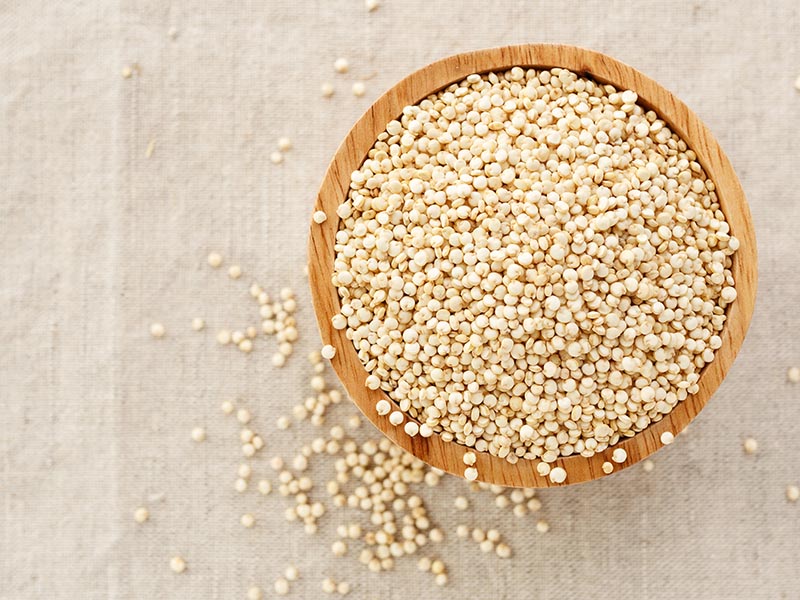
Quinoa seeds, technically, are a fruit with a huge nutrient source. Indeed, they are high in minerals, proteins, dietary fiber, and vitamins (especially vitamin B). They were first livestock feed 7,000 years ago and have been used as human food for 4,000 years.
Native to the Andean area of South America, their popularity has spread to other continents like the Pacific Ocean (Australia), Europe, and Asia (India).
The typical way to prepare quinoa is boiling (like how you do with rice and couscous). They taste mildly nutty with a chewy and fluffy texture. Compared to rice, their flavor profile is quite close to brown rice but with a nuttier flavor.
And they contain a much higher amount of nutrients than white rice, with fewer calories and carbohydrates. So if you need a better solution for grainy dishes, quinoa is a perfect option.
Nutrient (cooked / per 100 g):
- Energy: 503 kJ
- Carbohydrates: 21.3 g
- Fat: 1.92 g
- Protein: 4.4 g
- Vitamin B3: 0.412 mg
- Vitamin E: 0.63 mg
- Magnesium: 64 mg
- Potassium: 172 mg
- Phosphorus: 152 mg
Cooking perfect quinoa is effortless if you follow this instruction.
Multiple Fruits
Basically, multiple fruits come from a group of pistils of numerous flowers. And when these flowers merge together, they create a mass of fruit. Below are 4 typical fruits in this multiple fruit group.
25. Pineapple
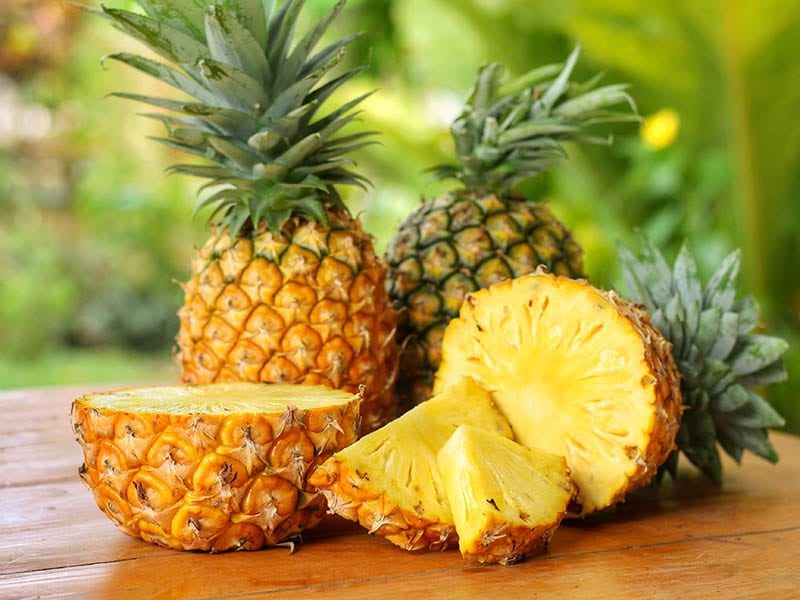
The domesticated pineapple species is unknown, but their first wild cultivar was found between Paraguay and southern Brazil. Moreover, they have become a significant fruit in South America for centuries.
In 2020, the Philippines was the leading producer of pineapples. The Philippines’ traditional dessert – nata de piña is made with fermenting pineapple juice. They are also a well-loved ingredient in other cuisines, like Taiwan, Mexico, Thailand, and some European countries.
Many pineapple types have sweet and sour flavors with firm, juicy flesh; they are best to eat fresh or mix them in your juices, smoothies, cocktails, or desserts. They can go great with savory dishes, like pizza.
Nutrients (per 100 g):
- Energy: 209 kJ
- Sugar: 9.85 g
- Vitamin B1: 0.079 mg
- Vitamin C: 47.8 mg
- Magnesium: 12 mg
- Choline: 5.5 mg
- Calcium: 13 mg
- Potassium: 109 mg
The quickest and simplest way to cut pineapple without waste is here.
26. Fig
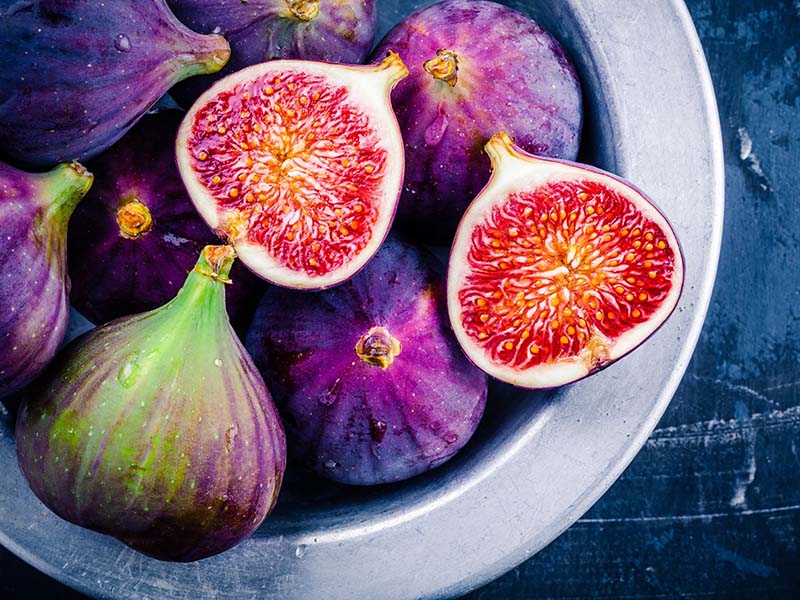
Originating in western Asia and the Mediterranean, nowadays, figs are the famous fruit in Turkey with around 300,000 tons annually, making them the top producer worldwide.
Other countries in North Africa (e.g., Morocco, Egypt, and Algeria) are also significant fig producers.
Fig comes in a tear-shaped form with around 1.2 to 2-inch long. They contain many edible crunchy seeds with sweet soft flesh in red color. Despite eating them fresh, you can spot them in a jam, dried, or other processed form since they are quite fragile to transport.
If you love baked goods, use fid to hold the moisture in these dishes. It only takes 1 to 2 days from unripe to ripe ones, so ensure you consume them quickly. Otherwise, if they have a sour smell, your figs are overripe.
Nutrients (per 100g):
- Energy: 310 kJ
- Carbohydrate: 19.2 g
- Vitamin B6: 0.1 mg
- Vitamin E: 0.11 mg
- Vitamin C: 2 mg
- Magnesium: 17 mg
- Calcium: 35 mg
- Potassium: 232 mg
27. Jackfruit
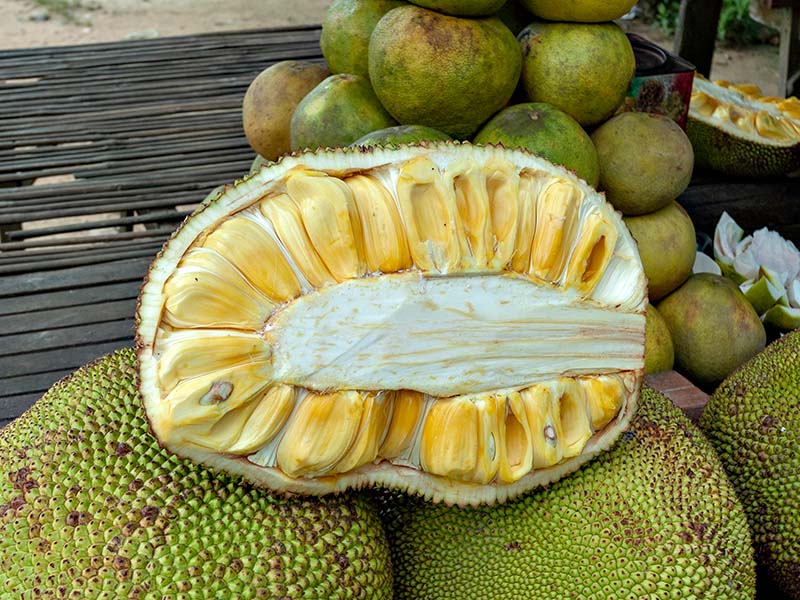
Jackfruit is a heavenly fruit with a “J-something” name, a large size (might reach 120 pounds), and sweet pulp when fully ripe. You can eat unripe fruits as well, but they’re pretty bland with a meat-like texture. That’s why many vegans use them to replace meat.
Many Asian recipes, like those foods in Indonesian cuisine, use young jackfruit, like salad, curries, or deep-fried ones for quick chips. This fresh fruit, obviously, is best to eat raw. They are also available in dried, canned, frozen foods, or syrup form.
Jackfruit originates in Southeast and South Asia. Plus, they are the national fruit in Bangladesh. Jackfruit has many varieties, and they are known for their distinguished fruity amora. You can mix them with other fruits like mango, banana, apple, or pineapple.
There are around 100 to 500 seeds per fruit. And they are edible as long as you cook them, like boiling, roasting, and baking. Jackfruit seeds have a nutty and creamy flavor mixed between chestnuts, potatoes, and chickpeas.
Nutrients (fresh fruit / per 100 g):
- Energy: 397 kJ
- Sugar: 19.08 g
- Protein: 1.72 g
- Vitamin B6: 0.329 mg
- Vitamin C: 13.8 mg
- Magnesium: 20 mg
- Calcium: 23 mg
- Potassium: 448 mg
Other multiple fruits: Mulberry, osage-orange, breadfruit, etc.
Aggregate Fruits
Aggregate fruit derives from 1 flower with multiple pistils. And there are some “berries” in this group, like strawberry, raspberry, and blackberry.
However, some flowers with many ovaries cannot produce aggregate fruit as these ovaries cannot tightly join together. And some aggregate fruits can be false fruits (accessory fruits) formed from other flower parts than the ovary.
28. Blackberry
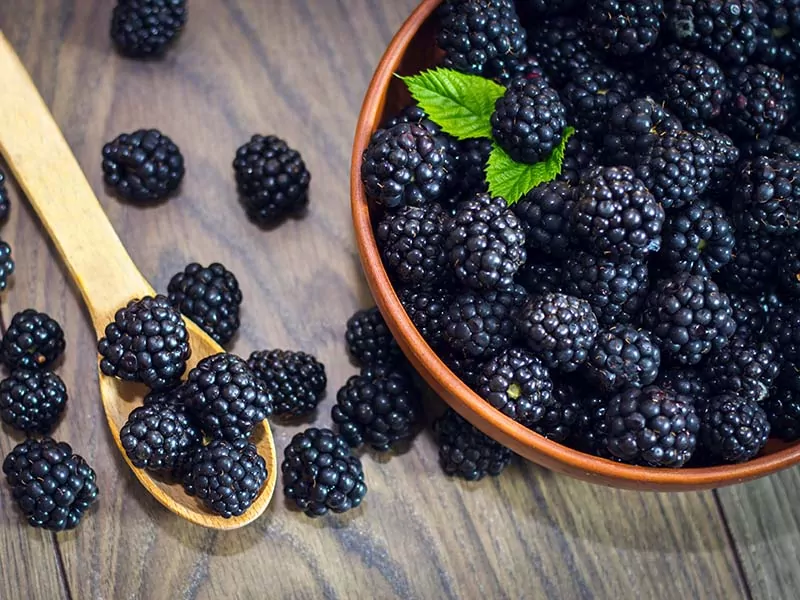
If you want to grow a “berry” in your backyard, blackberries would be ideal since they are very easy to thrive. They are small fruits composed of various drupes (called drupelets in botany terms).
They turn from white to red to black with a sweet-and-tart flavor when they are fully ripe, but immature ones might be sour, bitter, or blander. When mature, they are also super juicy fruits to eat alone, or you can mix them with your dessert or breakfast to add some fruity taste.
Moreover, blackberries are the perfect component for making jam, jelly, candy, liquor, and wine. People also use their fruits, stems, and leaves to dye hair and fabric.
On the other hand, blackberries can grow well in the wild or cultivated. Today, there are more than 375 species of blackberry around the world, and Mexico is the leading producer currently.
Nutrients (per 100 g):
- Energy: 180 kJ
- Protein: 1.39 g
- Vitamin A: 21 mg
- Vitamin C: 1.17 mg
- Vitamin K: 19.8 μg
- Magnesium: 20 mg
- Phosphorus: 22 mg
- Calcium: 29 mg
- Potassium: 162 mg
29. Raspberry
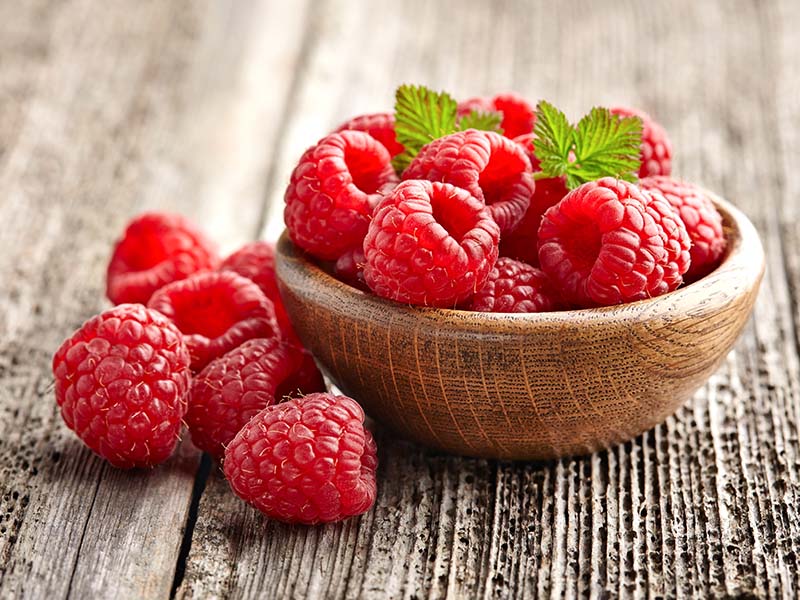
Black raspberry and blackberry might confuse many people, but their core is the main distinction to tell them apart. If you see a soft green or white center, they are blackberries. In contrast, black raspberries have a hollow core.
There are multiple raspberry kinds, but most raspberries you can buy in the market have a vibrant red color, regardless of fresh or frozen forms. In 2020, Russia was the number 1 raspberry production with 182,000 tons, followed by Mexico, Poland, Serbia, and the USA.
Like blackberries, they are small fruits made from about 100 drupelets. Their weight ranges from 0.11 to 0.19 ounces, making them an ideal fresh snack, or use them for your juice, puree, or baked goods, like raspberry pies.
To make herbal teas, people can consume raspberry leaves too, either fresh or dried. Though there is no proven proof about their medicinal purpose, many think these leaves are a good treatment for some remedies.
Nutrients (per 100 g):
- Energy: 220 kJ
- Choline: 12.3 mg
- Vitamin E: 0/87 mg
- Vitamin C: 26.2 mg
- Calcium: 25 mg
- Phosphorus: 29 mg
- Potassium: 151 mg
- Magnesium: 22 mg
Are raspberries safe for the keto diet? Let’s hear an expert explain it.
30. Custard Apple
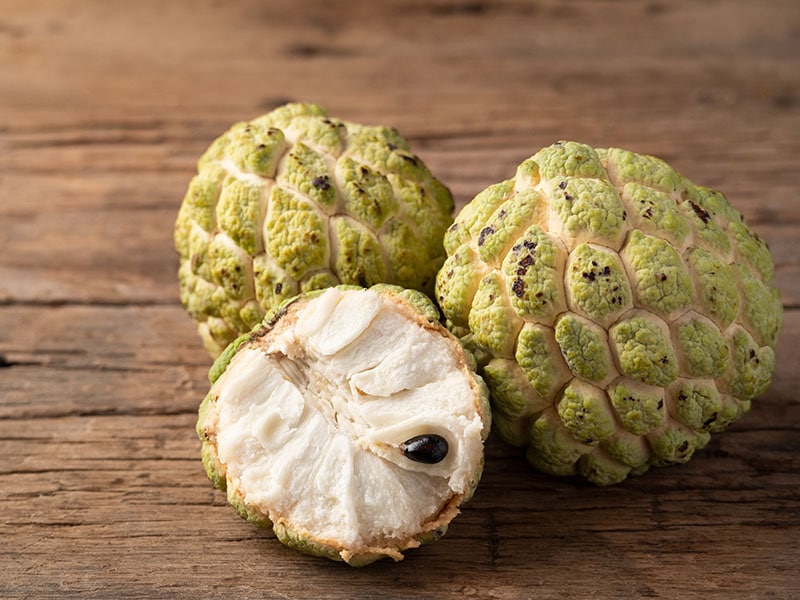
Another aggregate fruit is custard apple, which might not look attractive, but its flavor is amazing. Their flesh is pleasantly sweet, custard-like, and juicy with a nice aroma.
Based on their varieties, they come in a heart-shaped, oblong, or spherical appearance (from 2.8 to 4.7 inches). Their color varies, which can be dark brown, yellow, or pale green and leathery skin and white flesh. To enjoy them, you can use your hand to gently squeeze and separate them in half.
There are several black seeds inside the flesh, so make sure you remove them when eating. And only consume them when they are soft and moist. If you see them turn black, they might be overripe.
They are best suited to eat on their own, so you do not have to add any seasoning. Their fresh white pulp can also fit in your salad, ice cream, milkshake, and even smoothies.
Nutrients (per 100 g):
- Energy: 101 kJ
- Protein: 1.7 mg
- Carbohydrate: 25.20 mg
- Dietary fiber: 2.4 mg
- Vitamin C: 19.2 mg
- Potassium: 382 mg
- Calcium: 30 mg
31. Strawberry
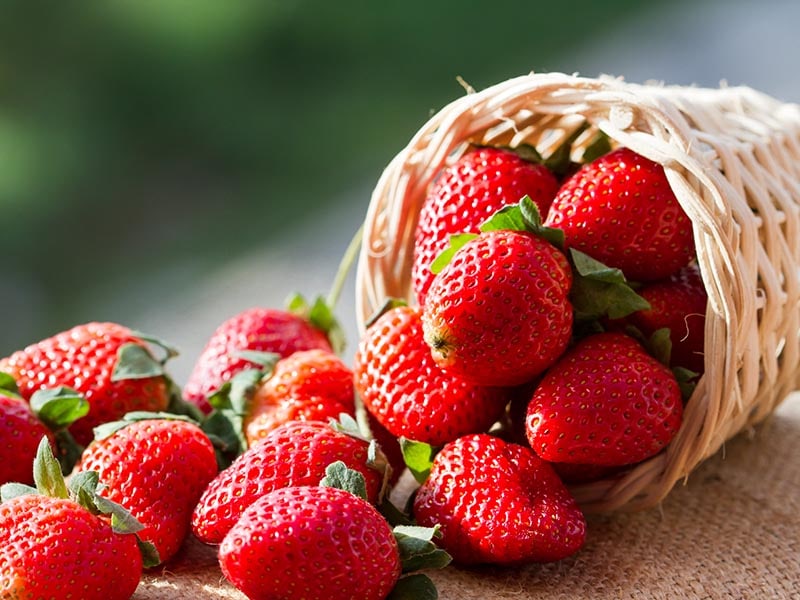
Strawberries are one of the main flavoring stars in smoothies, yogurt, ice cream, and milk. But they are also perfect on their own as a light snack or used to make jam or dried foods. As a whole, the popularity of strawberries around the world is undoubted.
The initial garden strawberry was found in Brittany (France) in the late 18th century. And as mentioned above, in the botany world, they are not a true berry. Strawberry varieties vary regarding shape, color, size, and even flavor.
Ripe strawberries have a balanced sweet and sour to provide the best fruity flavor. They are also juicy, with 90.95 g of water content. The iconic color is bright red with multiple tiny seeds on the surface.
However, they can cause some oral allergies like hives or dermatitis, or affect breathing conditions. According to many studies, the anthocyanin in strawberries, besides their health benefits, can possibly result in side effects (e.g., liver damage) if you consume them in larger quantities.
Nutrients (per 100 g):
- Energy: 136 kJ
- Vitamin C: 58.8 mg
- Vitamin E: 0.29 mg
- Vitamin B3: 0.386 mg
- Choline: 5.7 mg
- Phosphorus: 24 mg
- Potassium: 154 mg
Growing strawberries at home is not too challenging with this guidance.
Tropical Fruits
Botanically, tropical fruit is not an official fruit classification. However, many Western people love them as they can hardly find these fruits in their countries.
Why? Tropical fruits can only develop well in tropical or hotter climates, such as in Asia, Central Africa, South America, the Caribbean, and some parts of the Pacific Ocean. They can be drupe, aggregate, or other types of fruits.
Here are some iconic tasty varieties with certain popularity in these countries. Check it out!
32. Dragon Fruit
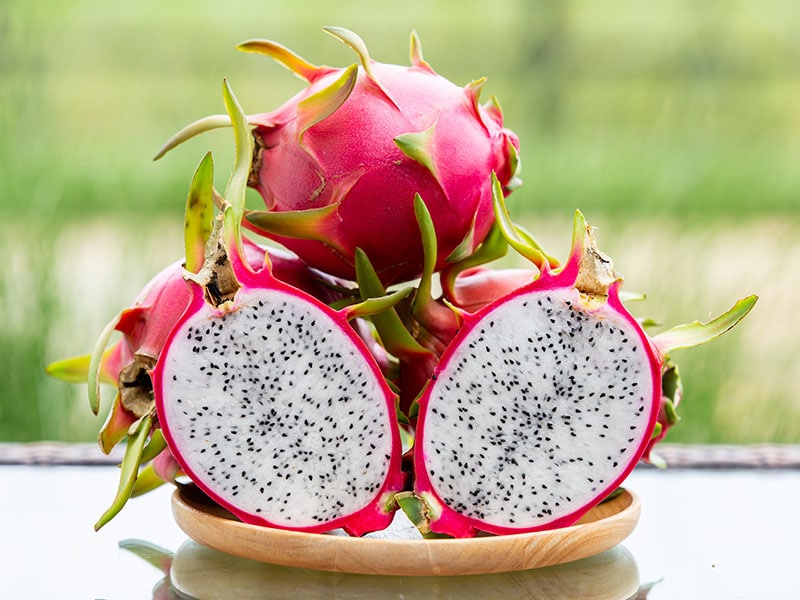
Dragon fruit, such a mysterious name! They have this name because of their leathery skin in reddish-pink color and green pointy scales on their oval appearance, which resemble a dragon look. However, the root of this fruit is from Central and South America.
They are also popular fruit in Mexico (where locals refer to as Pitaya), Southeast Asia, Australia, America, and India. As a whole, they suit well in subtropical and tropical countries. Another fun fact about this fruit is they belong to a cactus species.
Several dragon fruit varieties have different tastes ranging from sour (like sour pitayas are more common in arid areas in the Americas) to sweet (mostly). Their normal flesh is white with numerous tiny black seeds, but some may have red flesh.
If you see them come in yellow skin, this one is the sweetest kind that originates from Ecuador, Israel. Overall, a mature dragon fruit weighs from 5 1/2 to 21 oz; bigger versions might be around 2 lb.
Nutrients (per 100 g):
- Energy: 1,100 kJ
- Carbohydrates: 82.14 g
- Protein: 3.57 g
- Vitamin C: 9.2 mg
- Sodium: 39 mg
- Calcium: 107 mg
If you are unsure whether your dragon fruit is ripe, check this instruction.
33. Passion Fruit
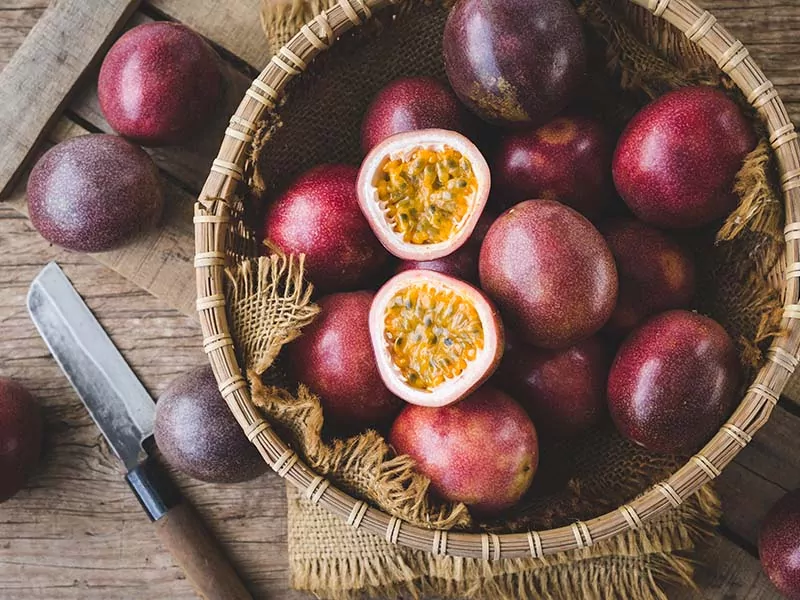
In botany, passion fruit is a true berry in pepo type. They feature a round to oval fruit ranging from 4 to 7.5 cm in diameter and about 35 grams. Their sizes also rely on passion fruit varieties; overall, they are relatively small fruit.
Their color might be bright yellow (golden passion fruit) or purple (like those in Australia). Purple passion fruits are smaller than yellow ones, but their taste and aroma are a big advantage. This fruit has a smooth leathery skin with 9 to 13-cm thickness, and there will be more wrinkles when aged.
Passion fruits originate in Southern Brazil, Paraguay, and the northern areas of Argentina. But as they are tropical fruits, they can cultivate well in other subtropical and tropical countries. These ball-sized fruits are juicy and sweet, with multiple edible seeds inside.
There is no limitation in consuming them as they can taste best in the raw form or pair with salads to enhance your dishes’ overall flavor and aroma. Moreover, use it to make oil, wine, jam, juice, or ice cream flavorings.
Nutrient (per 100 g):
- Energy: 406 kJ
- Protein: 2.2 g
- Water: 72.9 g
- Vitamin A: 64 μg
- Vitamin C: 30 mg
- Calcium: 12 mg
- Magnesium: 29 mg
- Potassium: 348 mg
34. Lychee
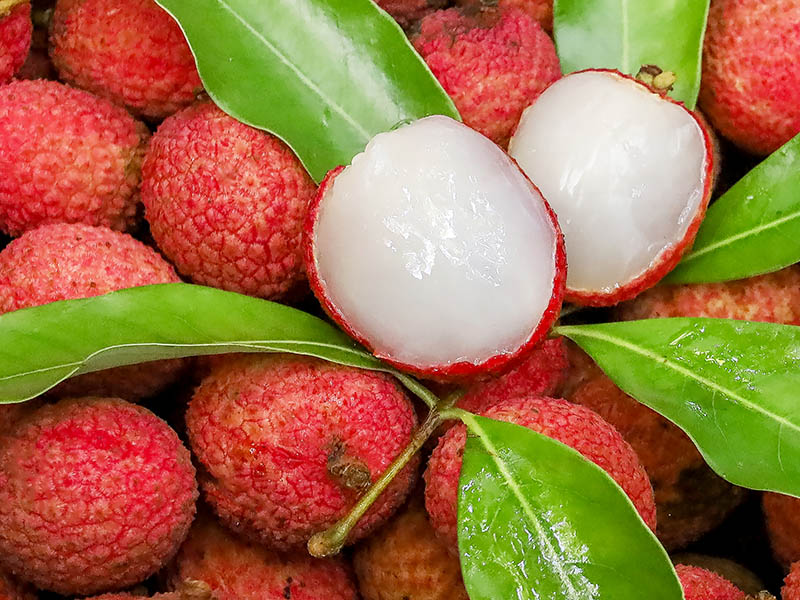
Lychees is one of many special Chinese-originated fruits with sweet and super juicy flesh. The best way to eat them is to enjoy them raw, but it does not mean that they are not versatile. Many Asian-style desserts contain lychee, and I cannot even describe the exact level of their tastiness.
Native to several provinces in China’s Southeast and Southwest, lychees’ popularity slowly spread to other Western countries, thanks to their refreshing taste. However, as they can only grow best in tropical climates, lychee’s price in Western nations might be a bit high.
The mature lychees have a round or heart-shaped appearance with 2-inch long and 1.6-inch in width. Their tough skin has a red or reddish-pink color with a pretty rough texture. However, you can still easily peel them off to enjoy the opaque white flesh inside.
It is hard to convey the flavor of lychees by words because you might sense the cross-flavor of watermelon and strawberry in this fruit. They also have a light note of roses. But the main flavor profile of lychee is sweet and aromatic.
They also have a hard seed in the middle that you should not discard while eating. Nevertheless, ensure that your children consume them with a full stomach and in a limited amount since lychees link to some deter illnesses.
Nutrient (per 100 g):
- Energy: 276 kBJ
- Water: 81.8 g
- Vitamin C: 71.5 mg
- Potassium: 171 mg
- Calcium:5 mg
- Phosphorus: 31 mg
- Magnesium: 10 mg
The review of lychee flavors will make you want to try them immediately.
35. Papaya
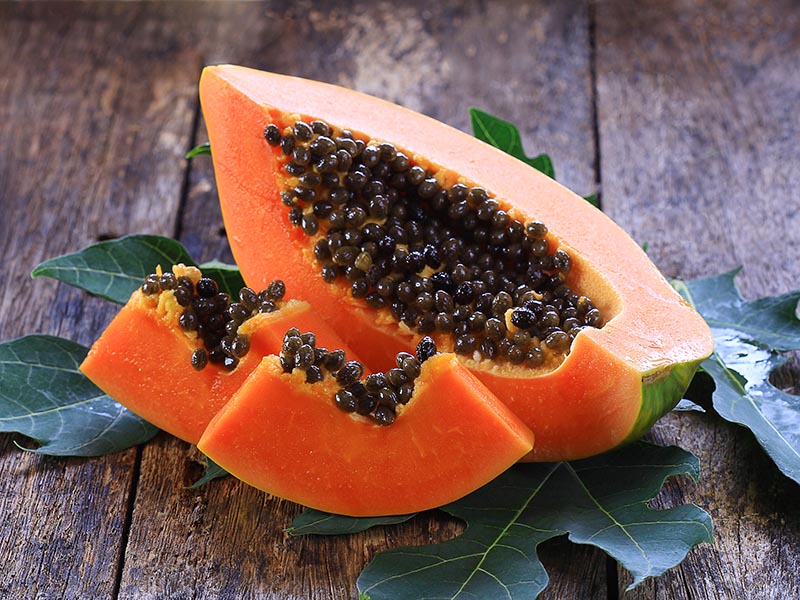
What makes you love papaya? Is it their light sweetness of juicy flesh? Papaya has a large pear-shaped form, but the funny thing is they come from a small tree. They are native to tropical areas in the Americas, like Southern Mexico and Central America.
Today, you can find them worldwide, especially in Southeast Asia, India, Hawaii, and Australia. Though they have many varieties, 2 big papaya kinds are orange-red flesh (or yellow flesh) ones with sweet flavor, and green papaya, which are picked when they are immature.
Normally, the sweet types are ideal for eating fresh, or combined with your yogurt or smoothies, while the green ones are perfect in a salad, like Som Tam of tasty Thai foods. Since they are unripe, their flesh is still white with a super mild flavor that you can barely recognize.
Papaya has countless seeds that you can eat too. Their flavor is totally different from the flesh as you can sense a light spiciness from these small seeds.
Nutrient (per 100 g):
- Energy: 179 kJ
- Vitamin A: 47 μg
- Vitamin C: 62 mg
- Vitamin E: 0.3 mg
- Potassium: 182 mg
- Calcium: 20 mg
- Magnesium: 21 mg
Other tropical fruits: Pomegranates, pineapple, mangosteen, jackfruit, etc.
Exotic Fruits
Similar to tropical fruits, exotic fruits are not a specific fruit group. But they deserve a particular section since they are unique fruits that you might not easily find in your local markets.
Instead, exotic fruits are distinguished food in certain places around the world. The following 3 examples will tell you more about how amazing they are.
36. Durian
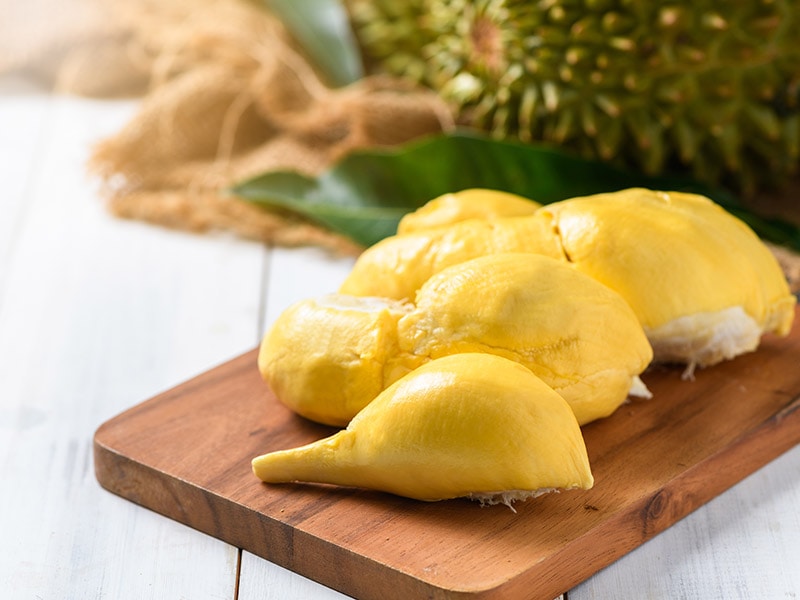
Durian is a native fruit of Malaysia, Indonesia, Thailand, and the Philippines with an unforgettable smell. Many people describe them as the smelliest fruit in the world, but is it true?
Indeed, many countries’ public transportation and hotels prohibit durian since it has a strong odor that some people think its smell resembles the rotten smell of onions or turpentine. But once you try and love this fruit, you will be addicted to its strong yet sweet fragrance.
Durian flavor is a combination of vanilla and caramel with a mild note of bitterness. Their flesh is creamy and sweet. Besides consuming durian fresh, this fruit is an ideal flavor for many Indonesian dessert ideas or Malaysian sweet treats like ice cream, candy, cakes, milkshakes, etc.
The appearance of durian is also unsightly, with many pointy spikes. Their sizes vary based on durian varieties that can be around 12-inch long and 6-inch in diameter. They have a husk green to brown color with pale yellow to red flesh.
The nutrients in durian are wonderful as well. Their flesh is rich in palmitic acid and oleic acid with a moderate amount of vitamins B, C, and other minerals, which can prevent heart diseases and lower cancer risk.
Nutrient (per 100 g):
- Energy: 615 kJ
- Fat: 5.33 mg
- Vitamin B1: 0.374 mg
- Vitamin B6: 0.316 mg
- Vitamin C: 19.7mg
- Potassium: 436 mg
- Copper: 0.207 mg
- Magnesium: 30 mg
If you are unsure about whether to try durian, this introduction might untie your knot.
37. Rambutan
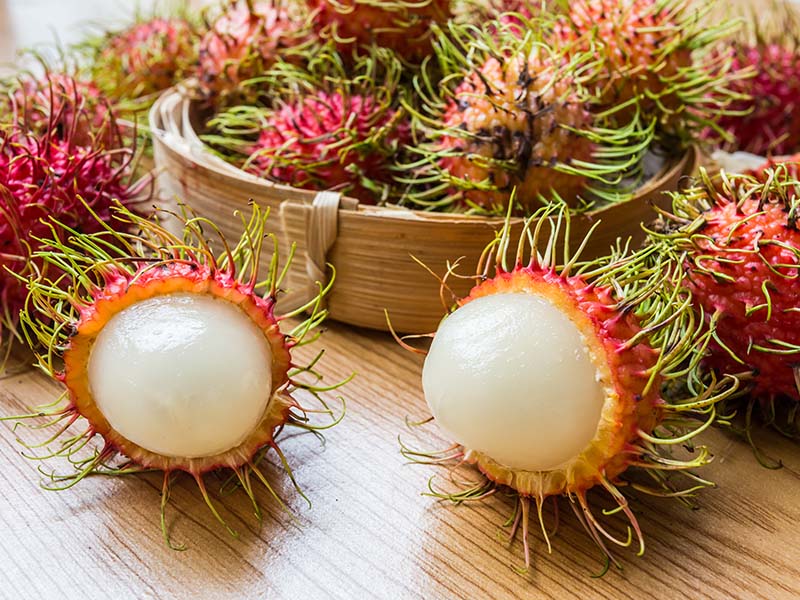
Rambutan – a tasty fruit beginning with the letter R, can be seen as a tropical fruit since they come from Southeast Asia countries. You can easily buy them in Indonesia, Malaysia, Vietnam, Thailand, Myanmar, or the Philippines.
They also appear in other regions like Oceania, Africa, Central America, etc., but might come at higher prices. This fruit is a close cousin of lychee, pulasan, and longan. In the Malay language, the term “rambutan” is from “rambut”, meaning “hair” to refer to the hair peel of this exotic fruit.
Rambutan belongs to the drupe group with a single inedible seed in the center. Their skin can be yellow, red, or green, which is leathery with many spines.
Removing their peel, you can enjoy a translucent white (or pale pink) sweet flesh with a flavor that resembles grapes and a mild sour and floral hint.
Nutrient (per 100 g):
- Energy: 343 kJ
- Carbohydrate: 20.87 g
- Water: 78.3 g
- Vitamin B3: 1.352 mg
- Vitamin C: 4.9 mg
- Calcium: 22 mg
- Magnesium: 7 mg
- Potassium: 42 mg
38. Horned Melon
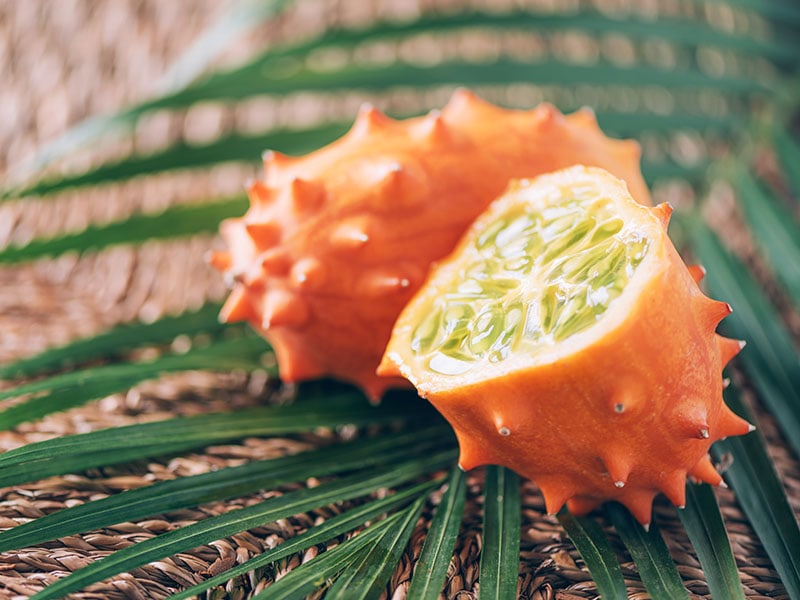
Horned melon (aka African horned cucumber, jelly melon, kiwano, etc.) is a well-known fruit with unround shapes that come from various African countries (e.g., South Africa, Angola, Zimbabwe).
This “H-something” fruit belongs to the vine group that bears small fruits. Each vine can yield around or over 100 fruits. The best thing about horned melons is you can consume them at any ripening stage. But if horned melons are overripe, they might burst to release their seeds.
They feature various horn-like spines on their orange skin. Their flesh looks like jelly with a lime green color. This fruit has a mild sweetness that crosses between cucumber, passion fruit, and zucchini flavor.
You can also sense a light banana hint when they are overripe. In Africa, the locals primarily use horned melon in their salad or snack, sometimes as a garnish.
Their rind is edible with a certain amount of vitamin C and dietary fiber. Moreover, though the flesh is full of seeds, you can enjoy them as well.
Nutrient (per 100 g):
- Energy: 183 kJ
- Vitamin B3: 0.565 mg
- Vitamin B5: 0.183 g
- Vitamin C: 5.3 mg
- Potassium: 123 mg
- Calcium: 13 mg
- Magnesium: 40 mg
- Iron: 1.13 mg
Other exotic fruits: Cactus fig, cherimoya, carambola, duku, and more.
Click here to find out the correct way to enjoy kiwano (aka horned melon).
Seeded vs. Seedless Fruits
Seeded fruits vary in type, but they all share 1 thing in common: the seeds are covered by fruits’ flesh or shell. In botanical language, “seed” also refers to dry fruits, like sunflower seeds, nuts (one-seeded fruits), or grains (e.g., rice).
Many fruit varieties are multi-seeded ones, such as jackfruits, passion fruit, dragon fruits, and more, in which seeds are either edible or inedible.
Seedless fruits are also popular, like pineapples and bananas. “Seedless fruit” might contradict the definition of fruit botanically which indicates any seed-bearing structures, but they are formed without fertilization.
Nowadays, people have created and cultivated many seedless fruit types, for example, citrus fruits, grapes, watermelons, etc. They are more convenient to consume, increasing their commercial value.
Fruits Are Not Only Fleshy and Juicy Ones!
Fruit in botany and culinary concepts might be slightly different from each other, but this post just showed you 35 botanical fruits with important roles in the culinary world.
So what are your favorites? If you still have other questions about them, leave the comment below so we can discuss more. And if you find this article helpful for your future reference, please do not forget to click like and share.
Thank you, and see you in the next article!
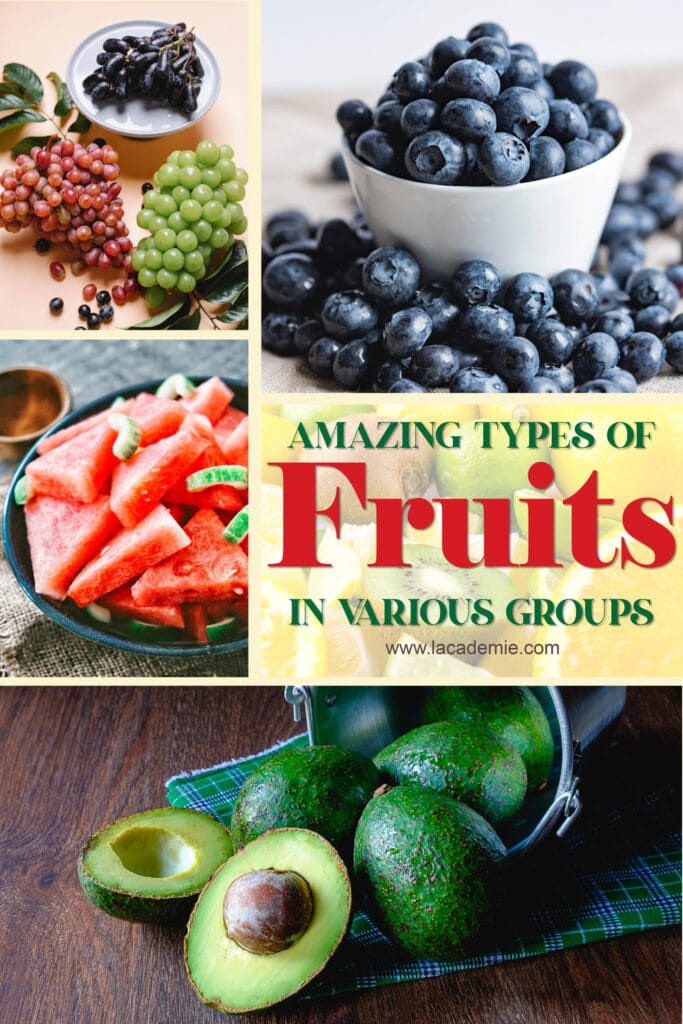


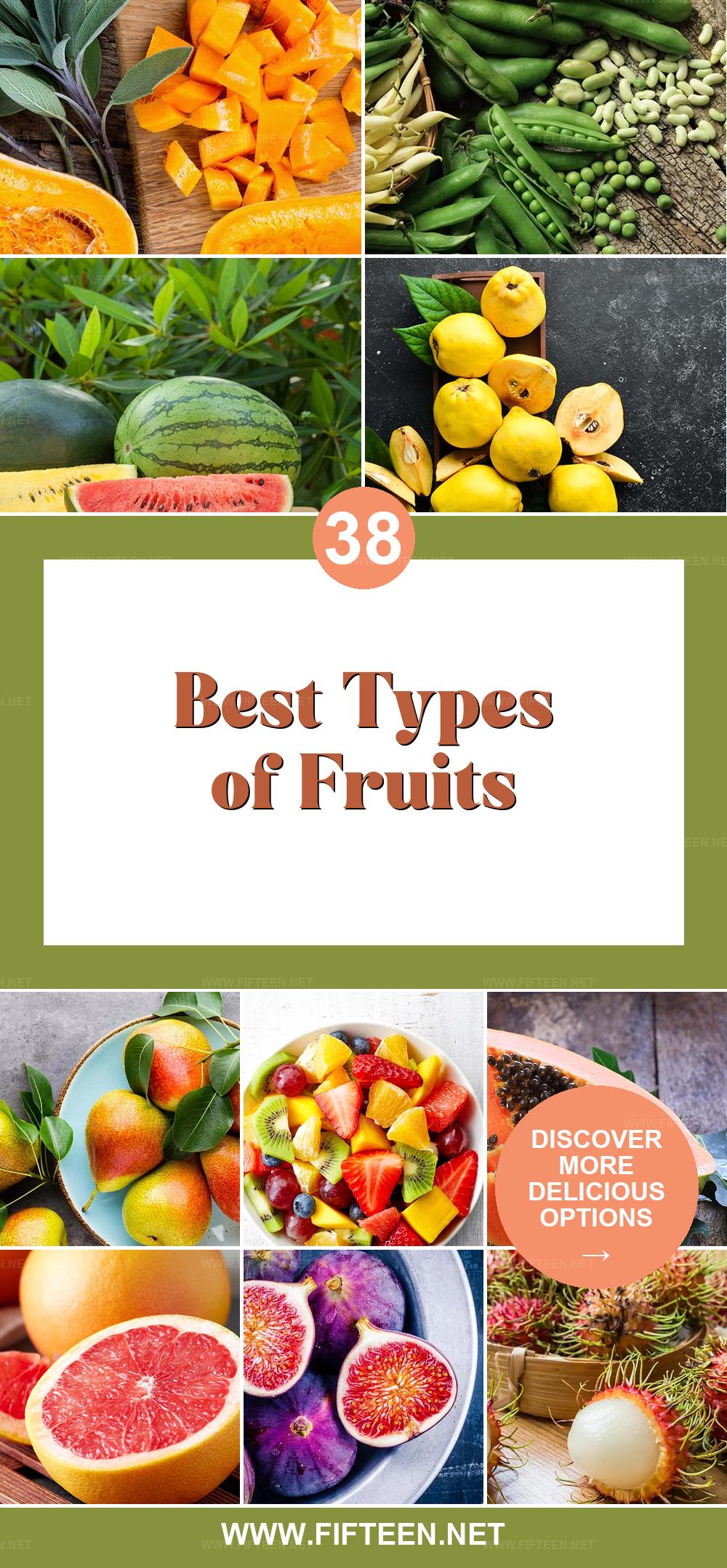
Jamie Scott
Editor in Chief, Senior Content Writer
Expertise
Home Cooking, Meal Planning, Recipe Development, Baking and Pastry, Food Editor, Cooking-video Maker, Western Food Evaluation Expert
Education
Le Cordon Bleu College of Culinary Arts
Local Community College, New York, NY
Jamie Scott is a skilled culinary expert and content creator specializing in Western cuisine. With over 15 years in the culinary field and formal training from Le Cordon Bleu, Paris, Jamie deeply understands how to blend nutrition with delicious flavors. His passion for cooking matches his commitment to making healthy eating accessible and enjoyable.
On Fifteen.net, Jamie brings a fresh perspective to classic dishes and beverages, offering readers insightful recipes, cooking tips, and a fresh view on meal planning that emphasizes taste, health, and simplicity.